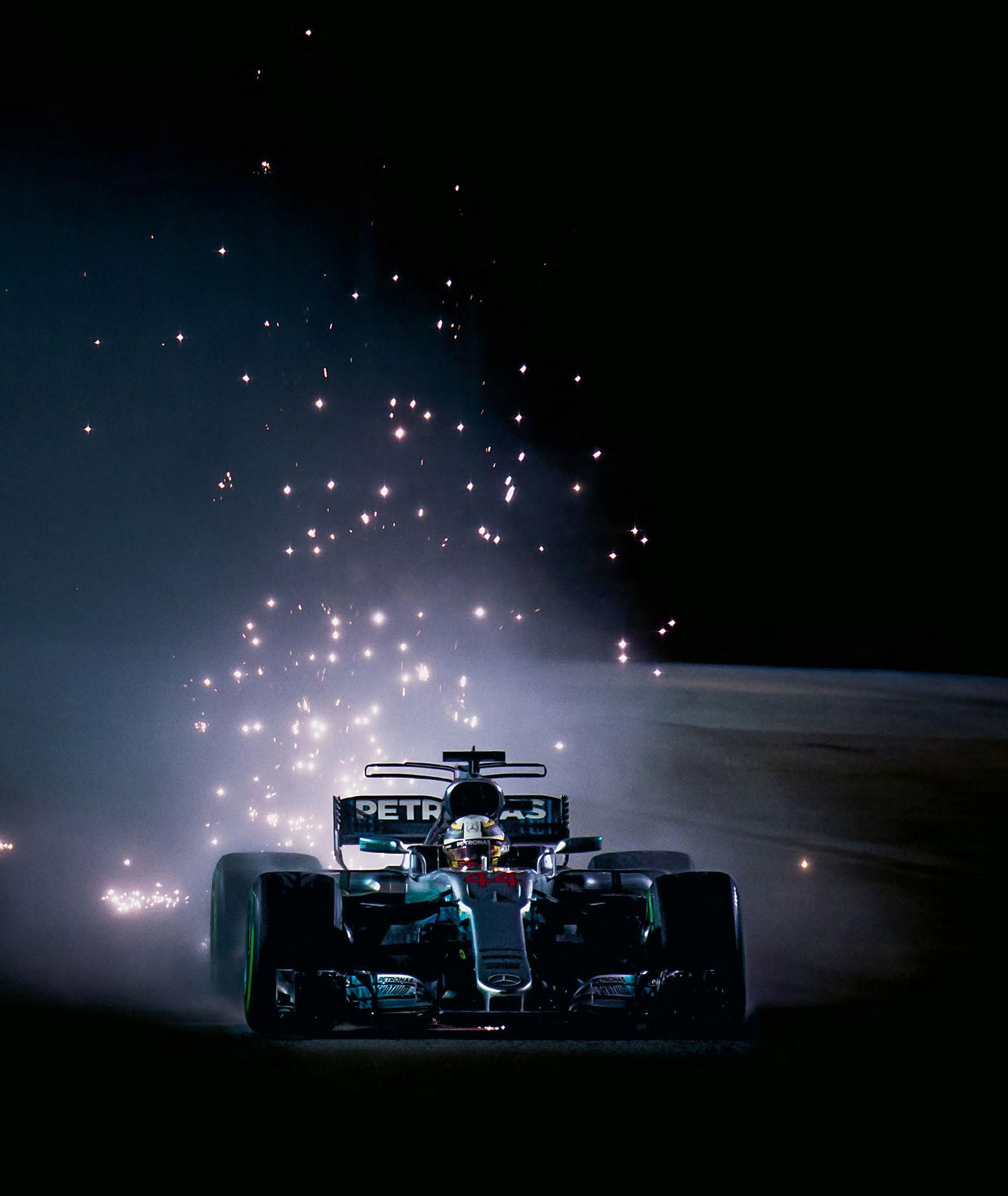

75 YEARS OF FORMULA ONE RACING GRANDS PRIX
Introduction by Sir Jackie Stewart
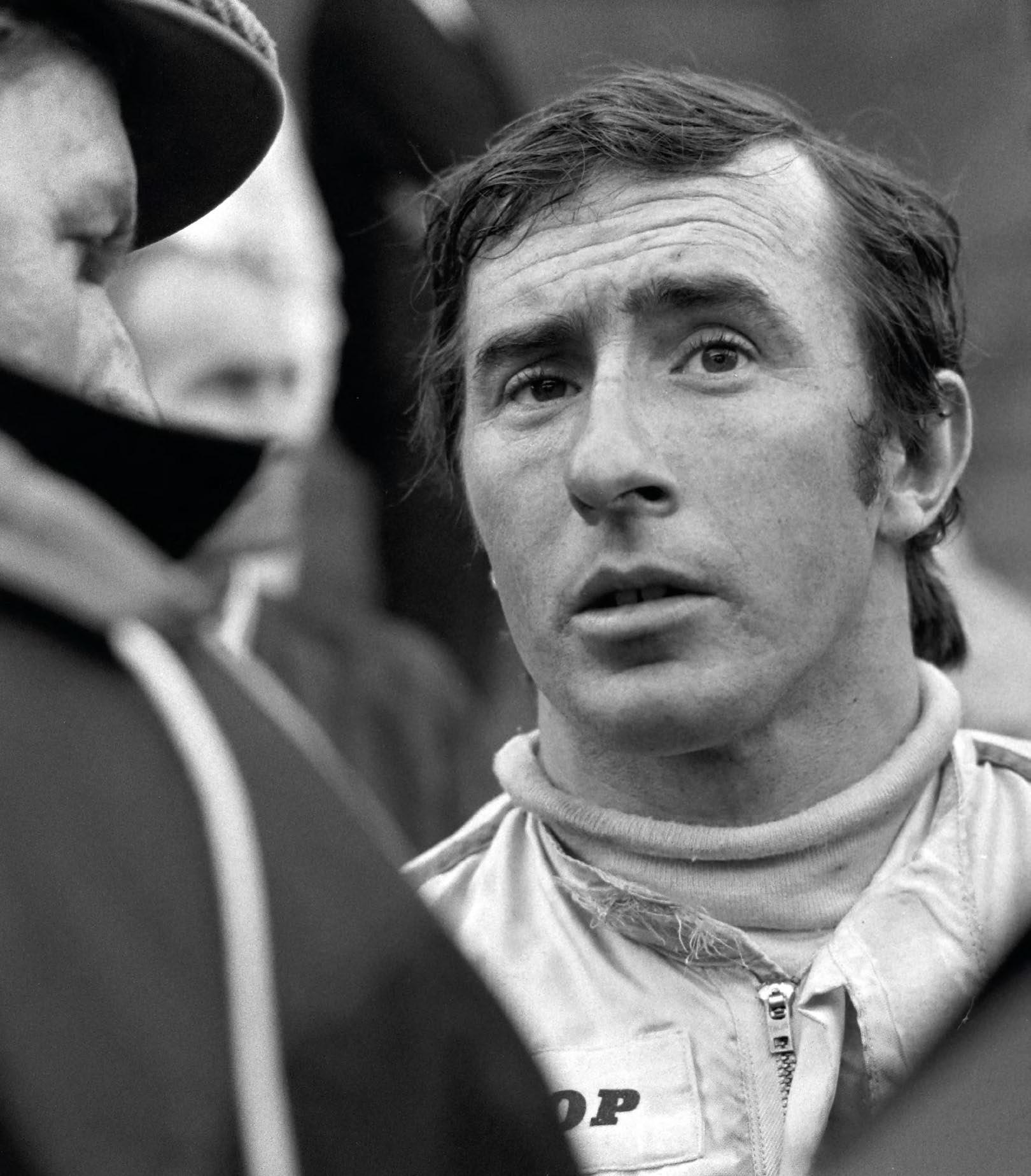
FOREWORD
by Sir Jackie Stewart
SPEED IS THE ESSENCE OF FORMULA ONE. Capturing speed is the essence of Formula One photography.
And it is through the images caught on camera since the 1950 British Grand Prix that we can best appreciate the grace, artistry and drama of this most compelling and dangerous sport.
We might linger on the view of the great Juan Manuel Fangio holding his Maserati 250F in perfect power slide. Or of my friend and hero Jim Clark guiding his rapier-like Lotus 25 with such precision none could touch him.
Maybe we would pause to reflect on the skill and daring of a young Jackie Stewart at the Nürburgring in 1968; or the courage of Niki Lauda returning to the sport with his wounds not healed after his terrible, fiery crash in 1976. What of Alain Prost, jumping for joy alongside his McLaren after securing the 1986 world title against the odds? All of these moments and so many more are contained in this wonderful record of 75 years of Formula One.
Many of these images stir deep memories –happy ones, of course, as they take me back to my youth, trying to forge a career in motorsport and ultimately winning my three World Championships. There is great sadness, too. Formula One was a deadly sport when I was racing and to see the faces of Jim, Jochen Rindt and François Cevert, among
many others, is a bitter reminder of the price demanded in pursuit of Grand Prix glory.
It is a great comfort that Formula One is a far less dangerous sport than it once was and that the likes of Sir Lewis Hamilton and Max Verstappen have been able to race ferociously in recent years without the peril once attached to Grand Prix motor racing.
Their achievements, like those of their predecessors, are celebrated in these pages and we can doff our caps to the craft and passion of the many immensely talented photographers who have preserved the sport forever through their work.
It is with heartfelt encouragement that I invite you to enjoy this feast of Formula One and Formula One photography.
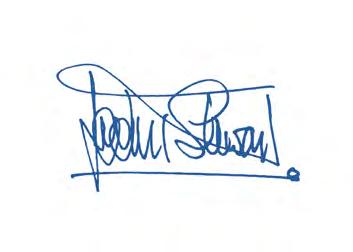
Formula One World Champion 1969, 1971, 1973
STEVEN TEE ON
AYRTON SENNA
Winning his first Grand Prix
THIS WAS MY FIRST FULL SEASON IN THE sport, and I was still young – only 23. Portugal was the second race of the year, and the abiding memory is that it was the most atrocious day on Earth, weather-wise. The rain wouldn’t stop, and it was really, really dark. We all went down to the first corner early to get a good, clean shot of the start –there were no photographers’ towers or anything like that – and we just stood there in the pouring rain, getting soaked. The most important thing when it’s like that is to keep your equipment clean. You spend a lot of time worrying about that.
I had come up through the sport with Senna, shooting him in Formula Ford and Formula Three and then in Monaco the year before, in similar conditions, where he should have won his first race. So, I knew how good he was in the wet. But, in 1985, I had the added pressure of being the team photographer for Lotus. Their team boss, Peter Warr, wasn’t completely convinced – sort of, ‘You’ve only been here two minutes and you’re our team photographer?’ Anyway, as the day unfolded, knowing how good Senna was in the rain and how good he was in general, it became obvious that he was probably going to win. So, then it’s all about being at the podium to get the pictures that I knew all our magazines and sponsors would want.
We used to shoot on colour and black-and-white film – no digital photography, of course – and I’d made the pragmatic decision to start shooting the podium in black and white. I found a little spot right at the end of the pit wall – a sort of raised concrete bollard – which I thought would be a good spot. I also knew that the cars would have to come past me to get to Parc Fermé. So, I stood there with my Canon F1, a 50mm lens and blackand-white film – all very basic. Just before I took the shot, Peter Warr wandered up to Parc Fermé and it became one of those things when there’s no
real time to think. Senna came down the pitlane, taking his belts off, and he saw Peter to his right, who has his arms outstretched. Manual focus, obviously, motor drive – and you’re just making sure your lens is clean. It was all a bit higgledypiggledy. You don’t know what you’ve shot.
After the race, there’s the usual rush to the airport, then back to the office to drop off the films for processing. Then, on Monday morning, there’s the nervous look along the lightbox…and this frame is the one that stands out – literally this one frame where it all comes together. Peter Warr’s got the perfect expression on his face and Senna is half out of the car. Then, on the left, you can see the two Goodyear-tyre guys, Kenny and Clive – that’s Kenny in mid-air – which adds to the picture. It probably works better in black and white than it would have in colour. There’s more depth of field. Also, the car is black with gold lettering and Senna’s helmet is yellow, of course, which all adds to the classic, monochrome feel. I think the picture has really stood the test of time.
When I first saw the shot, I remember thinking, ‘Peter can’t really argue about this’. He’d said to me on the plane home, ‘I hope you got some good pictures from today’. It was a big deal for Lotus because they hadn’t won a race since 1982 and they put all their eggs in the Senna basket. Obviously, it was a coming-of-age moment for Senna because he’d won his first Grand Prix, proving to everyone how talented he was. But it was a coming-of-age moment for me as well – a monkey off my back, in a way. I had shown that I could deliver to a team and their sponsors, and I was pleased on a personal level that the shot was completely exclusive. I’d found this one little place to stand, which could have been the worst, but turned out to be the best. Peter Warr had the picture framed soon afterwards and hung it on the wall of his office at Lotus HQ.

1985 Portuguese Grand Prix Estoril race circuit, 21 April 1985
Lotus-Renault 97T
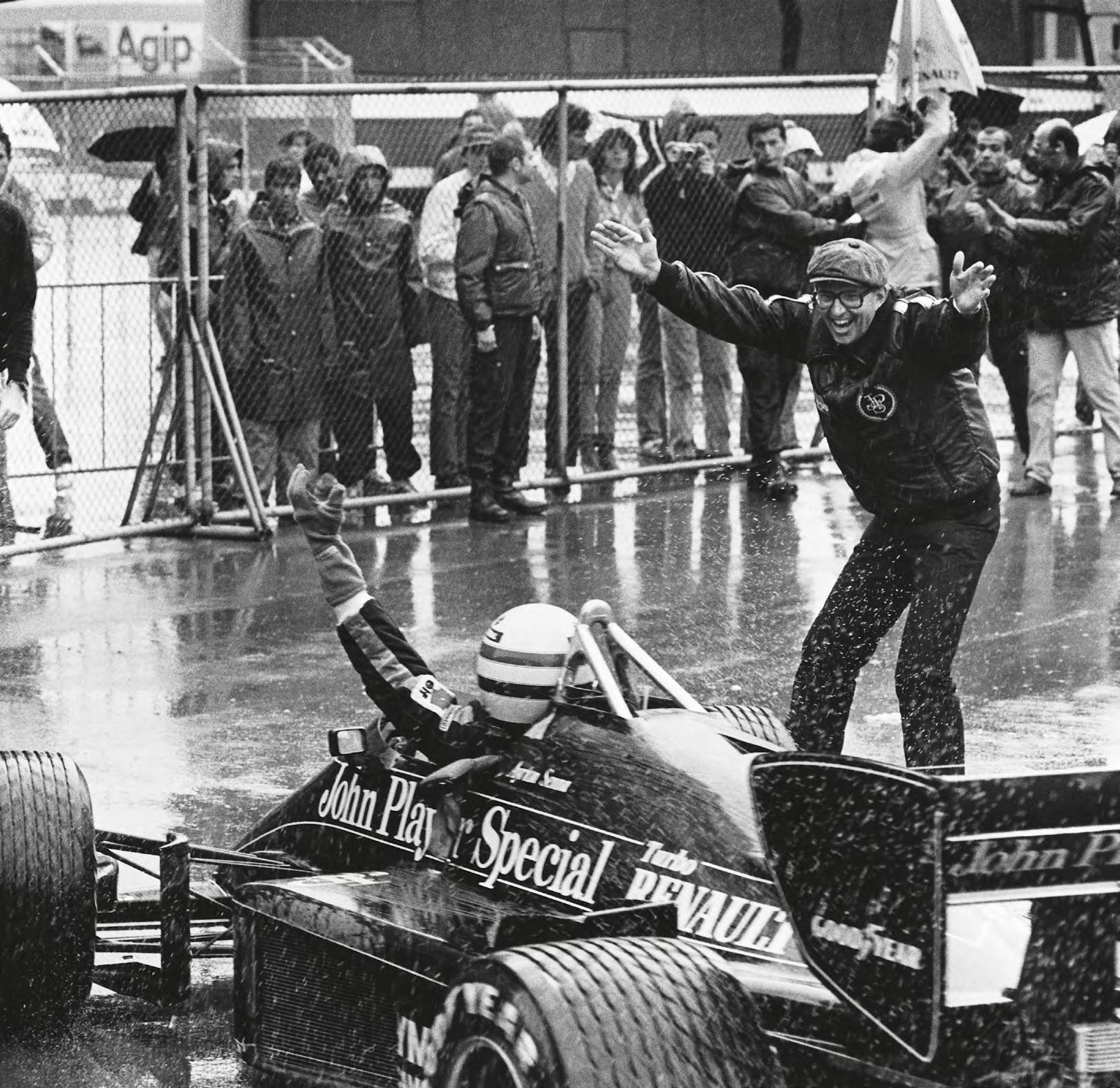
I STARTED TO SHOOT FORMULA ONE IN the 1960s and I began using the zoom technique you see here in 1969. The idea is that you have the centre of the car sharp – ideally the driver’s helmet – but the rest of the image has a speed-blur effect created by a very fast zoom on the image as the shutter closes. I took it during Saturday morning practice, and I’d been shooting other cars head-on at La Rascasse corner as they approached me. But when Stefan came past, I turned at the same time and my movements were totally synchronised with the car as it passed. And you can see this because the centre of the car is completely sharp, even as the background is blurred. Like a painting. I was deliberately trying to achieve this effect, but I was also lucky because, just as I pressed the shutter button, Stefan got back on the throttle as he exited the corner. That created two bursts of flame from the exhausts into the diffuser. This is what makes the photo so exciting, I think. You can try a thousand times to capture flames in a photograph, but it’s almost impossible, so there was definitely some good luck involved. By 1985, I had already been shooting F1 for more than 20 years, so I was quite experienced in terms of what I was trying to shoot, and also in terms of knowing how to work a circuit. Finding the right location for a shot is very important and if you stay in the sport for a while, you learn that track staff are often the same from year to year. So, if you get to know the marshals working on a particular corner, maybe they will let you stand in a place that’s not strictly permitted. That’s what happened with this shot: I was actually leaning against the barrier at La Rascasse, which you wouldn’t be able to do now. The barrier wasn’t high – maybe just a metre or so – and my camera was touching it. It was incredibly close to the cars; they were just the other side of the barrier, almost touching the metal. People have asked if the ’80s were the best time to shoot Formula One but I don’t think it’s as simple as that. It’s not the cars themselves that make pictures spectacular, it’s the opportunities that you have as a photographer. With this picture, you know, there was just a little barrier between me and the car – in the decades before, there was nothing at all. Now there are many more restrictions on where you can shoot, which limits the possibilities. It’s all for safety of course.
When I first saw this picture on the Monday after the race, once the film had been developed, I was really happy with it. It had Monaco, a Ferrari, flames… all the elements, really, to make it work. But, still, you can never know if you’ll capture an image like this. A good picture can work without words. The picture itself is the language and I think that’s the case here. When Stefan saw it, he loved it, and you can still see it on the homepage of his website. It’s funny… it was entered into a photography competition that year. It didn’t win.
SCHLEGELMILCH
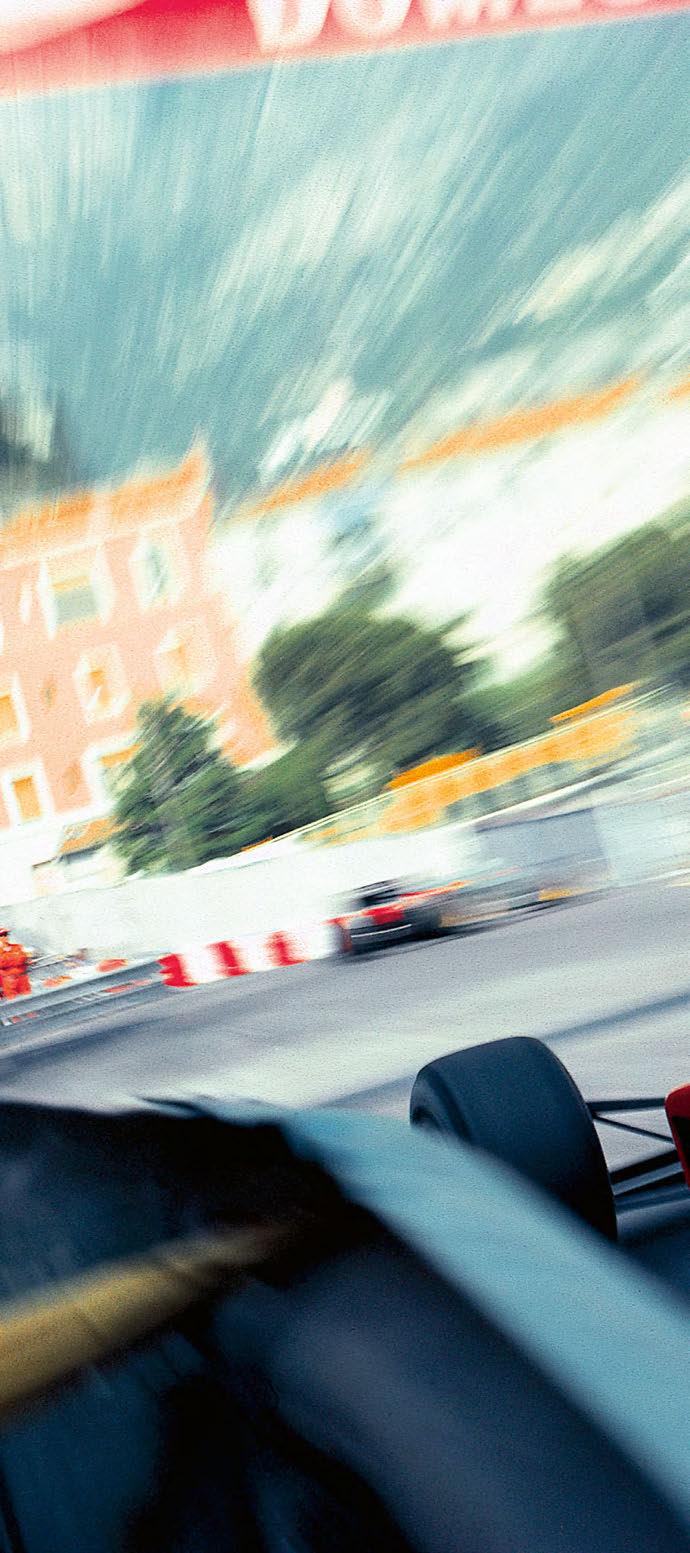
STEFAN JOHANSSON
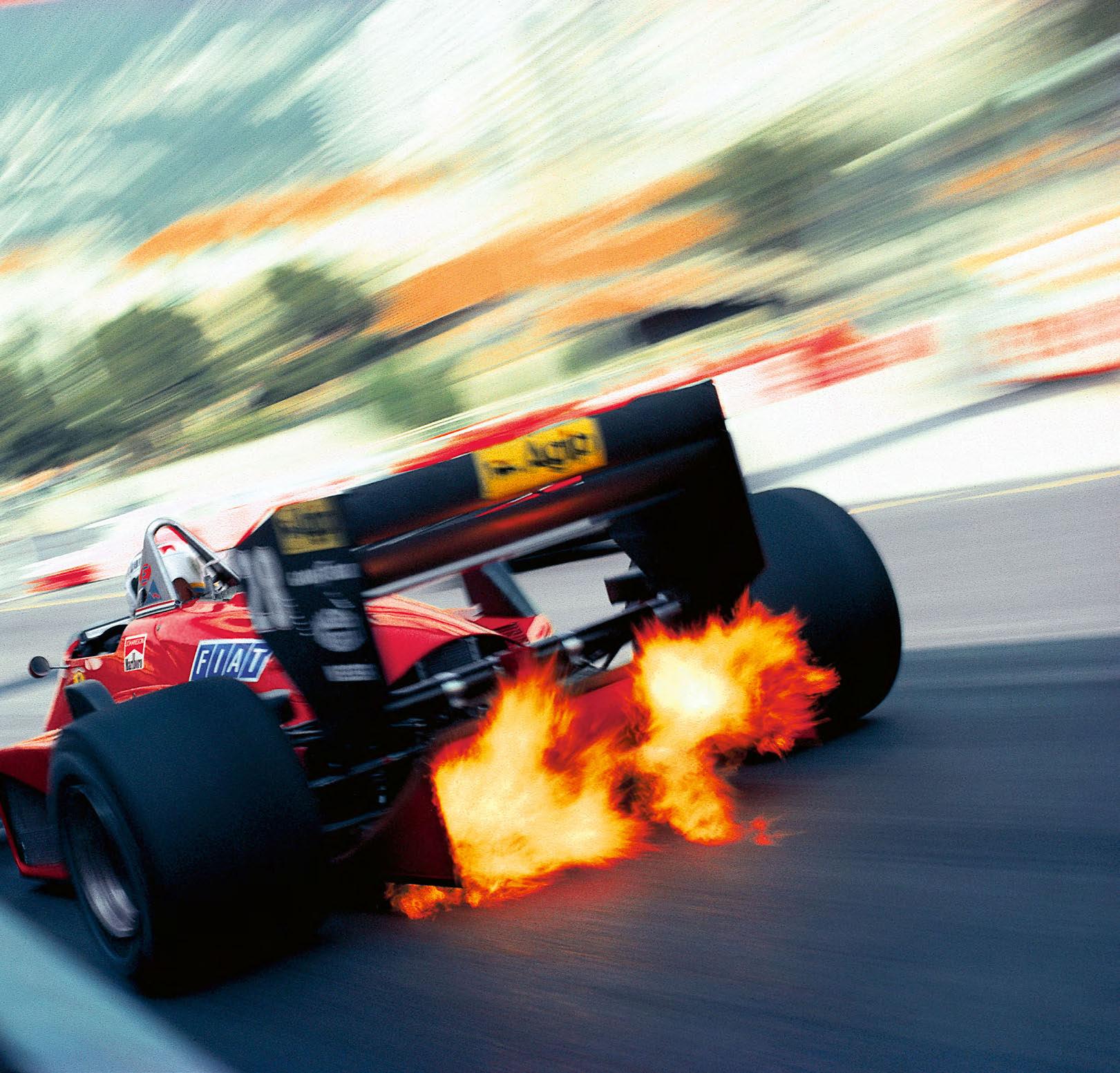
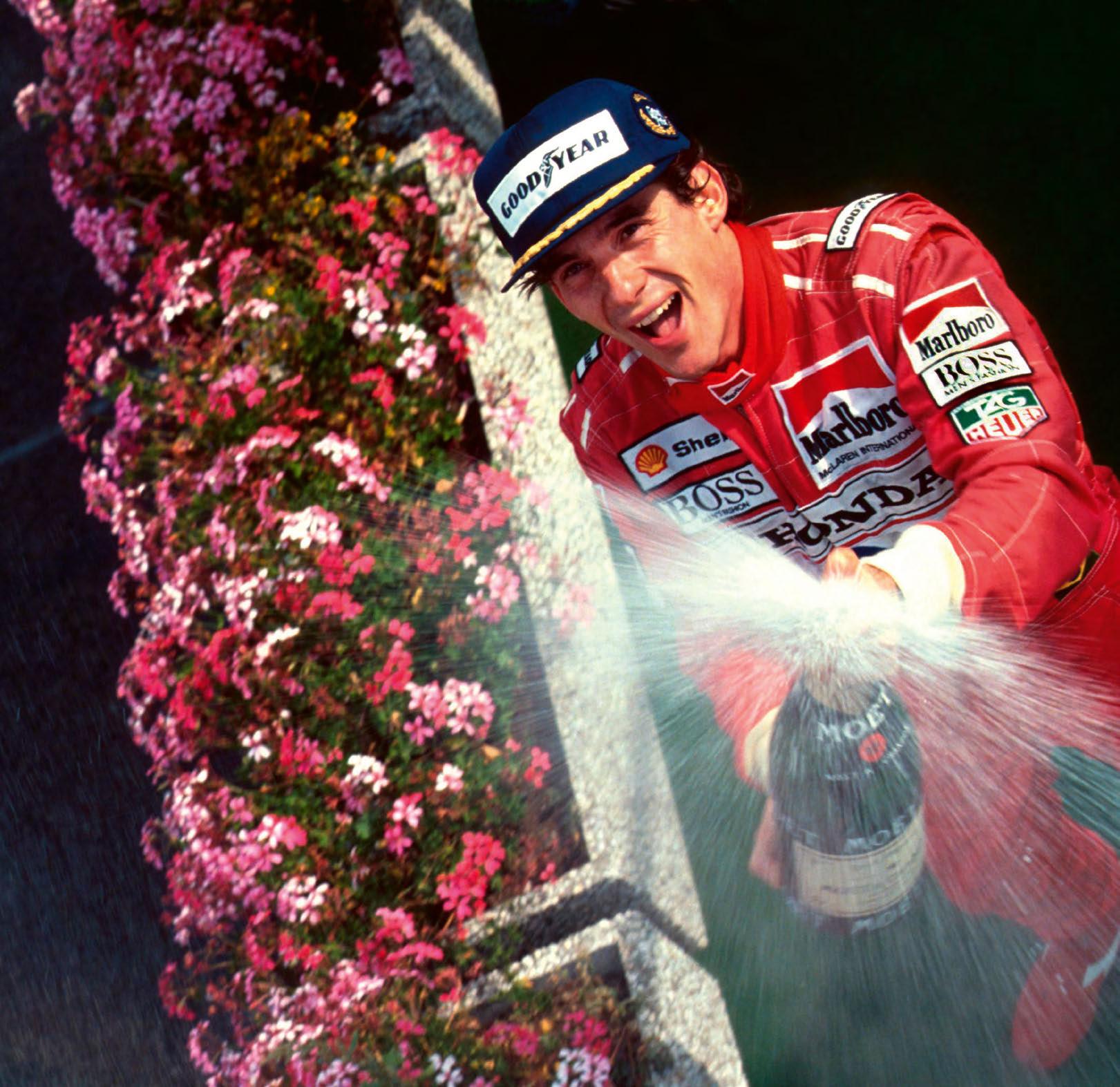
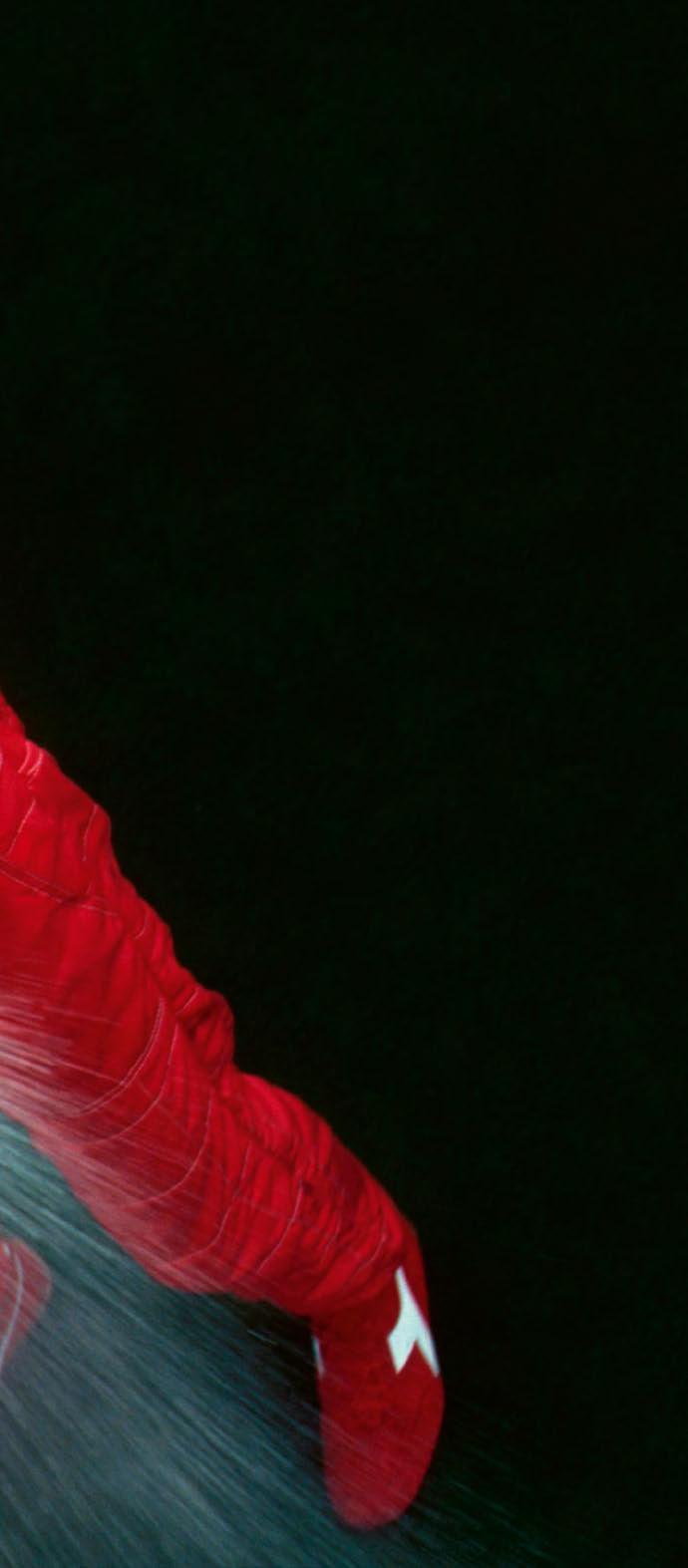
KEITH SUTTON ON
AYRTON SENNA
Celebrating victory
Belgian Grand Prix
Spa-Francorchamps circuit, 25 August 1991
MY ASSOCIATION WITH AYRTON WENT back to 1981, when he first came over from Brazil to race in the UK. I worked as his photographer in the junior British racing categories, and we were both at the same stage in our lives – young, ambitious, trying to prove ourselves and determined to get to Formula One. Ayrton made it with the Toleman team in 1984, after winning the British Formula Three title the year before. Over the next decade, I took thousands of shots of him. This one is of his podium champagne celebration after winning the 1991 Belgian Grand Prix. What makes it unique is that it’s shot from overhead, and Ayrton is looking right into my camera as he sprays the champagne. Most podium shots are effectively head-on and from beneath the drivers, but the special angle for this one is thanks to a little office I’d found in the circuit buildings on the morning of the race. I’d been walking out of the press room and saw a room with a door ajar and I went in for a look. I could see straight away that the window had a view straight down onto the podium. Even better, the window wasn’t locked, so I was able to hold my camera out and over the podium. I remember thinking, ‘This could be amazing,’ then shut the window and shut the door and kept very quiet about it for the rest of the day. I knew I couldn’t tell anyone and would just have to sneak up there.
After the race, which Ayrton won, I headed back to the room, hoping I’d still be able to get in – and thankfully when I got there it hadn’t been locked. So, there I am, all on my own, looking down onto
the podium, waiting for the drivers to come out. Then I saw them. I shouted to Ayrton when he got hold of the champagne and he looked up and sprayed at me. I was shooting film, as we all were then, and I had five or ten frames left on my roll of 36. It was over in a few seconds, but I remember thinking, ‘I’m sure I’ve got something amazing’. I sort of knew straight away.
Then it was a matter of rushing back to wherever we’d parked the hire car, to escape the crowds and head to the airport. I went straight to the office from the plane to process the film and soon I was on the lightbox with the magnifying glass to check the sharpness and everything. There were probably three or four frames that were good, but this one was exceptional.
You always keep quiet if you think you have something special. In those days, you didn’t say anything until it was on the lightbox… and then you see the picture, your colleagues gather round, they see the frame and go, ‘Oh, wow!’
One of the things that’s so nice about it is that there’s no advertising in the background, just artificial grass and that lovely row of flowers. I shot on Fuji Velvia film so the colours are really bright. But what makes this so special is that Ayrton is so happy, so joyful, and that makes me remember him that way, and smile. Those 10 incredible years he was in Formula One and the three world titles… Whenever I look at this picture, the sadness of Imola 1994 sort of goes away. You can just remember the good times.
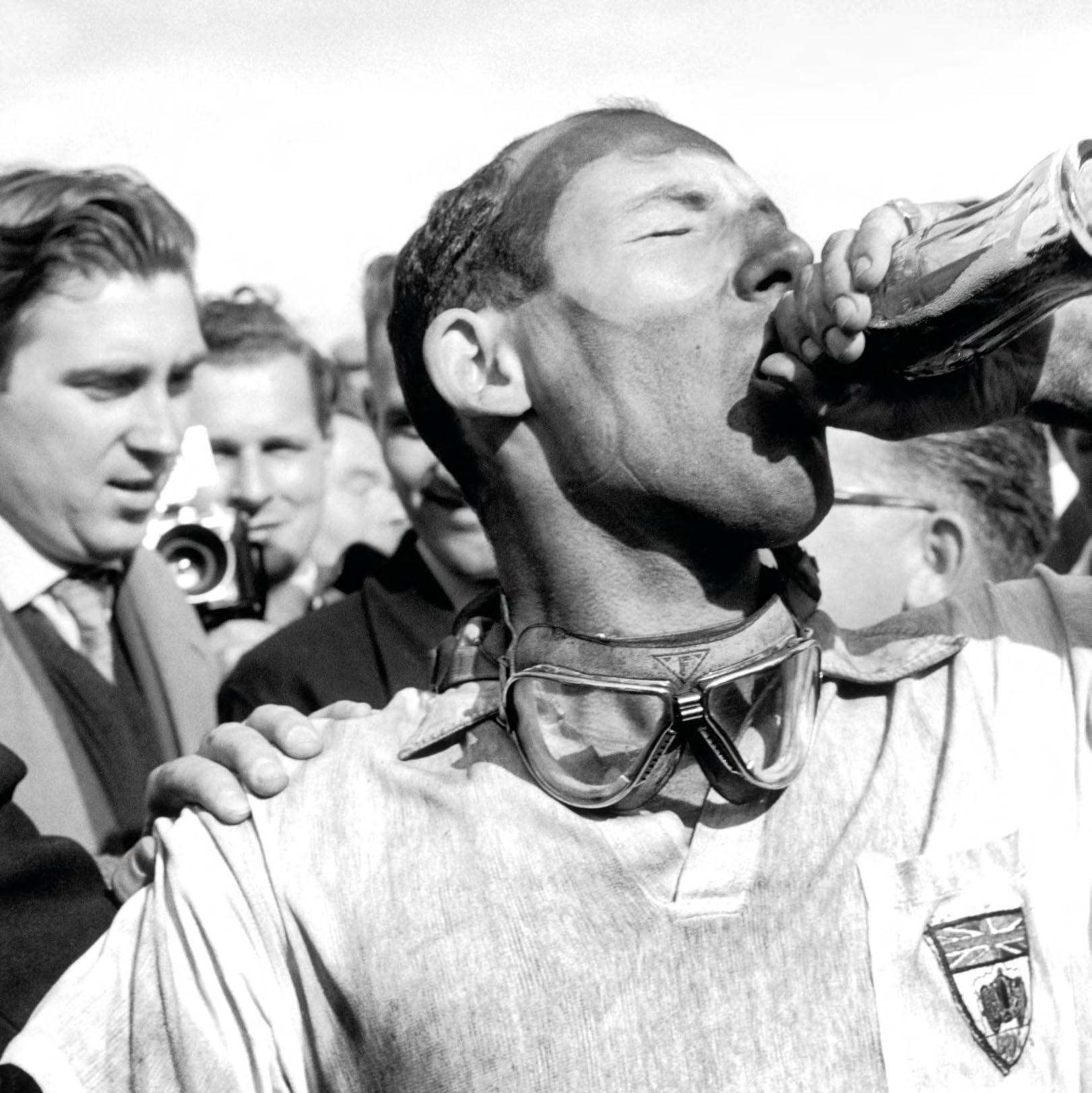

STIRLING MOSS
CAREER STATS
Wins: 16
Pole positions: 16
Fastest laps: 19
A HANDFUL OF DRIVERS IN THE 75-YEAR history of Formula One have transcended their status as greats to become timeless icons of the sport itself. Their stature assured, no further explanation is needed of their place in the pantheon. On any such list, hotly debated of course, names such as Ayrton Senna, Niki Lauda and Lewis Hamilton might well be pencilled in early. Before them all, written in ink, would be the name ‘Stirling Moss’, the very essence of a racing driver in his own time and in the decades that passed after his retirement.
At odds with his status is the fact that he never won the World Championship, despite being a recognised ace, yet that simple truth does more to devalue the world title than it does to diminish Moss’s standing. He won 16 Grands Prix in a Formula One career that spanned 1951–61 and broke into the winners’ circle at the 1955 British GP, ahead of his Mercedes lead driver Juan Manuel Fangio. Their single-season partnership at Mercedes remains one of the sport’s most fabled, the pair often running 1–2, with Moss happy to take the understudy role – a position he was only willing to accept for a driver he regarded as the greatest of all.
The true nature of their relative speed is open to debate and Moss was the faster of the two in sportscar racing outside Formula One. It was in that arena, driving the Mercedes 300 SLR, that he won the 1955 Mille Miglia race – a 1,000-mile sprint around open roads in northern Italy, with co-driver Denis Jenkinson as his navigational aide. Moss’s achievement in a race so dangerous that it was banned two years later after an accident that
killed driver Alfonso De Portago, co-driver Edmund Nelson and 10 spectators, five of them children, was his greatest, in his own view. In a 2012 interview with distinguished motorsport journalist Maurice Hamilton, he said, ‘If you’re talking about the skill of driving, not one of [my Grand Prix wins] equals winning the Mille Miglia in 1955. Averaging 97.7mph over 1,000 miles of public roads… The pleasure was remarkable’. As British drivers and manufacturers began to challenge the supremacy of rivals from continental Europe, Moss’s eminence in the late 1950s was huge. He finished runner-up in the World Championship in the four consecutive years from 1955 to ’58 and only lost out in that last season because of an act of high sportsmanship towards his countryman Mike Hawthorn. At the Portuguese GP, Hawthorn had been penalised for driving against the direction of traffic while returning to the track after a spin. Post-race, with Hawthorn due to be disqualified from second place, Moss offered testimony that, while Hawthorn had indeed driven against the track direction, he had done so off the circuit and therefore should not be penalised. Hawthorn’s result stood and he won that year’s title by a point, despite having won only a single Grand Prix to Moss’s four.
Moss raced for the next three seasons with the independent Rob Walker team, revelling in his underdog status driving customer Cooper and Lotus cars against better-funded factory entries. During this post-Fangio and pre-Jim Clark period, Moss was regarded as without peer by his rivals. His two 1961 victories at Monaco and Germany’s Nürburgring, ahead of more powerful Ferrari opposition, showcased his virtuosity, while cementing his legend.
A Ferrari future beckoned for 1962, Moss having agreed terms to race a customer car entered by Walker, but a near-fatal accident at the Goodwood circuit on Easter Monday 1962 guillotined Moss’s career. He was unconscious for a month after the crash, partially paralysed for six, and when he did venture back into the cockpit less than a year later, he found instinctive feel, touch and reaction no longer present. In time, his faculties might have returned, but aged 32 and at the peak of his powers, Moss called it quits. While Stirling’s racing days were over, the happy outcome was recovery to full health and long life. He died in 2020, aged 90, iconic to the last.


JACK BRABHAM
WORLD CHAMPION
1959–60, 1966
CAREER STATS
World title: 1959, 1960, 1966 Wins: 14
Pole positions: 13
Fastest laps: 12
MORE THAN 60 YEARS ON, THE SCALE OF Sir Jack Brabham’s Formula One achievements stand in epic scale: distant peaks that only gain enormity on closer inspection. Aside from the three world titles, which place him alongside fellow legends Sir Jackie Stewart, Niki Lauda, Nelson Piquet and Ayrton Senna, there was the pioneering trek from Australia to Europe to further his career; the founding of his own race team, with which he won his third drivers’ title; and survival, just staying alive during Formula One’s most perilous era.
A fascination with all things mechanical that drew Brabham inevitably towards motorsport began during his wartime service as a mechanic for the Royal Australian Air Force. Soon enough, he was using those fettling skills to gain a competitive advantage racing on Australian dirt ovals, where he’d begun to learn the rough-and-tumble racecraft that would become his hallmark as he progressed to the elite.
‘The most important step I had in my career was seven years on the speedway,’ he said in a 2013 interview with F1 Racing magazine. ‘I learned not just racing, also from the engine point of view. We started with a 1000cc engine which wasn’t anywhere near big enough and we stretched it to 1640cc. We made virtually every part of the engine.’ Seeking mechanical advantage would become a theme of Brabham’s career. Arriving in England in the early 1950s, leaving behind his wife and son, he immediately set about improving the sub-par machinery at his disposal: ‘The thing I missed most was my lathe,’ he said. ‘I struggled to get whatever I could, as I didn’t know the right people, and I made mistakes like buying the wrong car. I got talked into buying a new Cooper-Alta in England – which was an absolute disaster.’
Nonetheless, during visits to the Cooper Car Company, seeking better performance from his tardy steed, Sir Jack struck up a friendship with founder John Cooper. By 1959, the two were conquering the world: Brabham hustling the gamechanging rear-engined Cooper T51 to a drivers’ title, as Cooper vanquished mighty Ferrari in the Constructors’ Championship. A back-to-back title double played out in 1960, Ferrari out-smarted by a teak-tough Aussie and some impudent garagistas from South-West London.
And Brabham couldn’t get enough: ‘I loved beating Ferrari. In 1960 they invited me to meet Enzo in Italy, to talk about driving for him, and I never even went. I was only interested in beating them, not joining them.’ Given these sentiments, it’s little surprise Sir Jack selected his 1960 French GP win as his favourite. At the fast Reims circuit, whose long straights should have given the technically obsolete but still powerful Ferraris of Phil Hill and Wolfgang Berghe von Trips a top speed advantage, Brabham prevailed. ‘It was the most thrilling race I ever had. It was so close and then to nail them was great satisfaction.’
As the ’60s progressed, Formula One entered its notorious ‘killer years’: a decade of rapidly escalating speeds that accelerated car performance way ahead of safety provision. Brabham flourished, despite the peril and ferocity of competition. Among his rivals were the likes of Stirling Moss, Jim Clark, Graham Hill, Dan Gurney, John Surtees and Tony Brooks – winners and champions all. Moss’s track smarts in particular stood out: ‘He was a very hard driver and one to learn from –mainly about race tactics and determination. That sort of rubbed off.’
Brabham soon earned a spiky reputation of his own: a driver who’d think nothing of dropping a rear wheel off the track edge to pepper his pursuers with gravel, or of brushing a straw bale to fill their faces and radiator intakes with grassy scurf. Grit and technical acumen helped earn Brabham his third title in 1966, aged 40, in a car designed by his founding partner in the new Motor Racing Developments company, Ron Tauranac. With engines supplied by Melbourne machinists Repco – highly regarded by Sir Jack from his aero mechanic days – Brabham, team and driver, were F1 pace setters, as Brabham’s teammate Denny Hulme became champion in ’67. ‘Winning our own title was probably the pinnacle,’ he said. ‘It was a great achievement.’ To say nothing of simply not being killed in a race car at a time when Grand Prix racing was deadly.
In his autobiography, The Jack Brabham Story (2004), Sir Jack recalled his most serious accident during a test at Silverstone in 1969: ‘I’d got as far as Club Corner where we used to blast through at 115mph, and three-quarters of the way through, as I leaned on the left-front tyre, it popped off the rim and deflated. The car understeered into a bank [and] the impact smashed the left-front wheel into the side of the cockpit where it crushed the frame inwards, into my legs. The throttle was jammed wide open and behind me the engine was absolutely shrieking. The pain in my twisted legs and feet was unbelievable. There was a terrible stench of fuel. Looking over the cockpit side I could see a spreading lake of petrol and I knew if it ignited, I’d stand no chance.’ Brabham eventually found the engine kill switch, before being rescued by his senior mechanic, a certain Ron Dennis.
‘Black Jack’ remained a force through the late ’60s and was a race winner even in his 1970 retirement year. But it was the counsel of his father, Tom, after the 1970 Dutch GP, during which Piers Courage had crashed fatally, that convinced him to hang up his helmet. Bruce McLaren and Jochen Rindt had also died that year (Rindt becoming posthumous F1 Champion) and, while Brabham later considered he’d quit too soon, he had the priceless consolation of being able to reflect in his comfortable dotage on a unique racing career: that of a giant who bestrode F1’s shift from black and white to technicolour.
HE MIGHT HAVE BEEN A FILM STAR, HAD he not been born with petrol in his veins. Instead, the dangerously handsome François Cevert chose to pursue a career in motor racing, initially against the wishes of his wealthy parents but, in due course, with considerable success.
In 1971, racing for Tyrrell as the understudy to Jackie Stewart, he became only the second Frenchman to win a Formula One Grand Prix, picking up the baton laid down by Maurice Trintignant, who twice won the Monaco GP in the 1950s. His victory came at the very end of the year in the US GP at Watkins Glen and a joyful Cevert held both arms aloft as he crossed the line. It was only his 20th Grand Prix in his second F1 season, yet there was a sense that the win had been a while coming. Since joining Tyrrell in 1970, Cevert had quickly learned from the master and was often able to keep up with his illustrious lead driver. Two second places behind Stewart at the French, then the German, Grands Prix helped build momentum; when Stewart began to falter while leading at Watkins Glen, plagued by tyre trouble, Cevert was on his tail, ready to assume the lead.
It was a joyful moment for a young man whose comfortable passage through life seemed assured. A privileged background had allowed François the luxury of being able to fund his early racing adventures with private means and attend the French Winfield Racing School to learn the rudiments of his craft. Clearly talented, he topped his class to win a Formula Three car, in which he contested the 1967 French F3 Championship.
Cevert’s first season was hampered by his car’s poor performance, but switching to a Tecno chassis for 1968 set him up to win the title.
Tecno had been impressed by Cevert’s speed and took him on to race as a factory-backed driver in Formula Two in 1969. This allowed François, along with other leading F2 drivers, the chance to compete against Formula One stars in certain races which permitted entries from both categories. Stewart was one of many to notice Cevert’s talent and recommended that his team boss, Ken Tyrrell, keep tabs. When Tyrrell’s Johnny Servos-Gavin withdrew early in the 1970 season, a call was quickly put through to Cevert, who began his F1 career at the 1970 Dutch GP.
An unforced chemistry flourished between Stewart and Cevert, each benefitting from respective roles as master and apprentice, and they soon became an effective double act on track and firm friends off it. By 1973, with Stewart due to retire at season’s end, Cevert was finessing all he had learned in preparation to lead Tyrrell for 1974. Their final race weekend together would be the 1973 US GP, where Cevert was quickly among a group of drivers battling for pole position. It was while chasing top spot that Cevert lost control of his Tyrrell 006 at the Watkins Glen ‘Esses’ – a fast uphill part of the track with sharp left–right bends. His Tyrrell speared through a gap between two horizontal lines of safety barrier, destroying the car and killing Cevert instantly. His violent death remains one of the most gruesome in Formula One, many drivers admitting to being traumatised by what they saw. To this day, Stewart believes the loss of Cevert robbed France of its first World Champion.
CAREER STATS
Wins: 1
Pole positions: 0
Fastest laps: 2
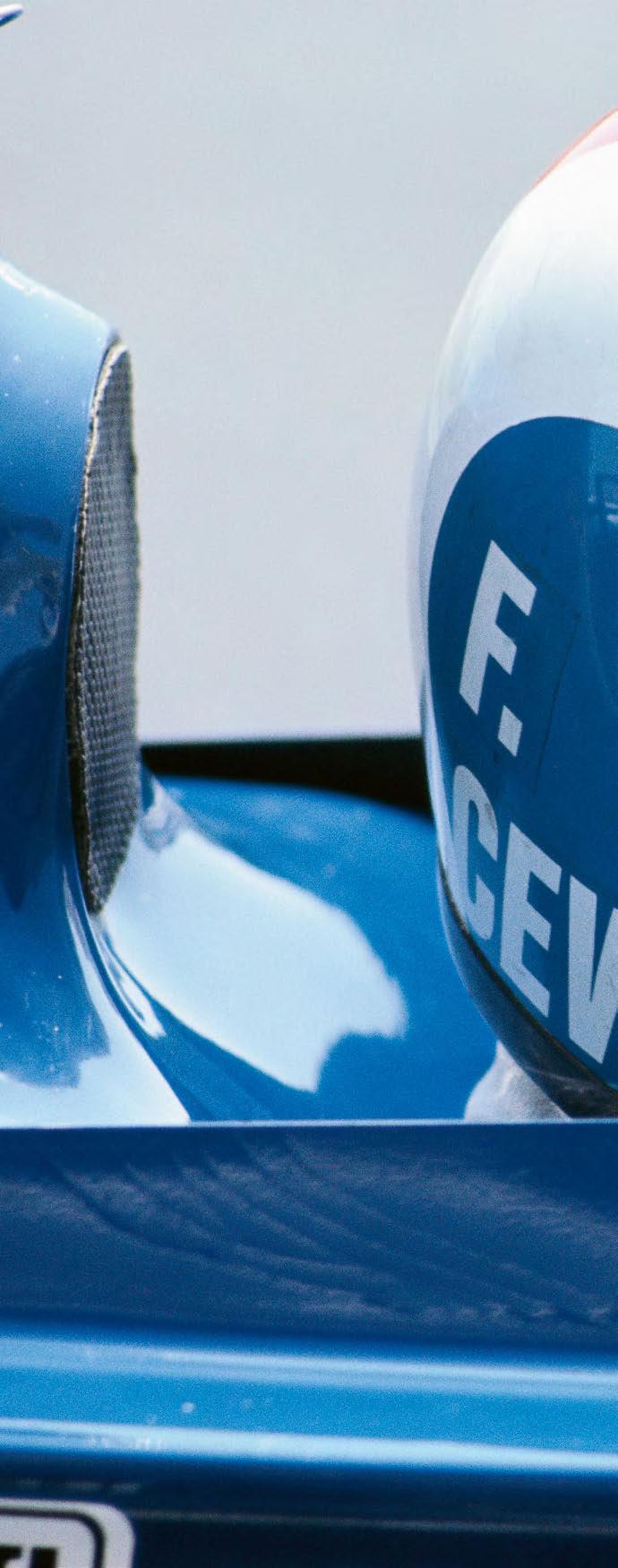

HE WAS THE ICE TO GILLES VILLENEUVE’S fire at Ferrari in 1981–82. An electrifyingly fast racing driver who succeeded in removing emotion from the intensity of competition, Didier Pironi was nonetheless incapable of escaping the vortex of circumstance that snatched both of Ferrari’s stars from the sport within four months of each other, from spring into summer of ’82.
Villeneuve died after a monstrous accident during qualifying for the Belgian Grand Prix, still feuding with Pironi in the wake of the San Marino GP two weeks earlier, which Villeneuve believed Pironi had won in breach of team orders. Pironi, dissociating himself from the frenzy that followed Villeneuve’s death, won again at the Dutch GP in July and, by the time of the German round at Hockenheim in August, he had carved a nine-point lead in the championship. Driving the year’s best car, Pironi was looking increasingly likely to win the drivers’ title – his life’s ambition.
The dream was shattered during Saturday morning practice for the German GP when he crashed at high speed on a soaking track in heavy rain. Didier’s accident was not dissimilar to Villeneuve’s at Imola. Pironi’s car moved to pass the slower Williams of Derek Daly but was unable to see the Renault of Alain Prost ahead, owing to spray thrown up from Prost’s tyres. Pironi hit Prost, launching the Ferrari into the air before smashing back to earth, destroying the car. Remarkably, given the violence of the accident and the catastrophic damage to the Ferrari, Pironi survived, though grievous injuries to his legs ended his F1 career, with four races of the season remaining. Even so, he lost the title by only five points to Keke Rosberg after one of the most volatile seasons in the sport’s history.
The calamitous ending to Pironi’s pursuit of the F1 title was at odds with the control this privileged, powerfully charismatic man had hitherto exerted over his destiny. Born into material comfort, Pironi studied engineering and might have pursued a career in the family construction business had he not felt the pull of the track and enrolled in the French Winfield Racing School. Graduating as the best pupil of the 1972 class, Pironi progressed through the ranks of French motorsport in tandem with compatriots Alain Prost, Patrick Tambay and René Arnoux, before making his F1 debut with the Tyrrell team in 1978, in which year he also won the Le Mans 24-hour race for Renault.
Two seasons with Tyrrell brought only handfuls of points, though a pair of podium finishes in ’79 were enough to pique the interest of the Ligier team for 1980. It was with Ligier that Pironi scored his first Grand Prix win in Belgium, taking the chequer almost 50 seconds ahead of Alan Jones. Pironi’s cool-headed approach to racing, allied to an unerring focus on his world title ambitions, made him an ideal replacement for Ferrari’s 1979 World Champion Jody Scheckter, who had quit after a desultory 1980 season.
Partnered with Villeneuve for ’81, Pironi came up against a teammate who, for the first time in his career, was his equal (or better) in pure pace. Both men struggled with the unruly power delivery and poor road manners of the Ferrari 126C, the team’s first turbo-charged machine, though Villeneuve rode the scarlet bronco to two victories, leaving Pironi chasing his shadows. Its 1982 successor, the 126C2, was far more to Pironi’s taste, though fate denied him the title that he admitted had seemed ‘within touching distance’.
Four years after the Hockenheim accident, Pironi drove an F1 car again, in private tests intended to establish if his legs were sufficiently healed to allow a racing comeback. The outcome was inconclusive and Pironi instead fed his competitive needs by racing offshore powerboats. It was in one of these dramatic machines – Colibri, a lightweight Class 1 design with twin V12 Lamborghini engines – that Pironi was killed in August 1987, along with two crew members, competing off the south coast of England.
DIDIER PIRONI
CAREER STATS
Wins: 3
Pole positions: 4
Fastest laps: 5

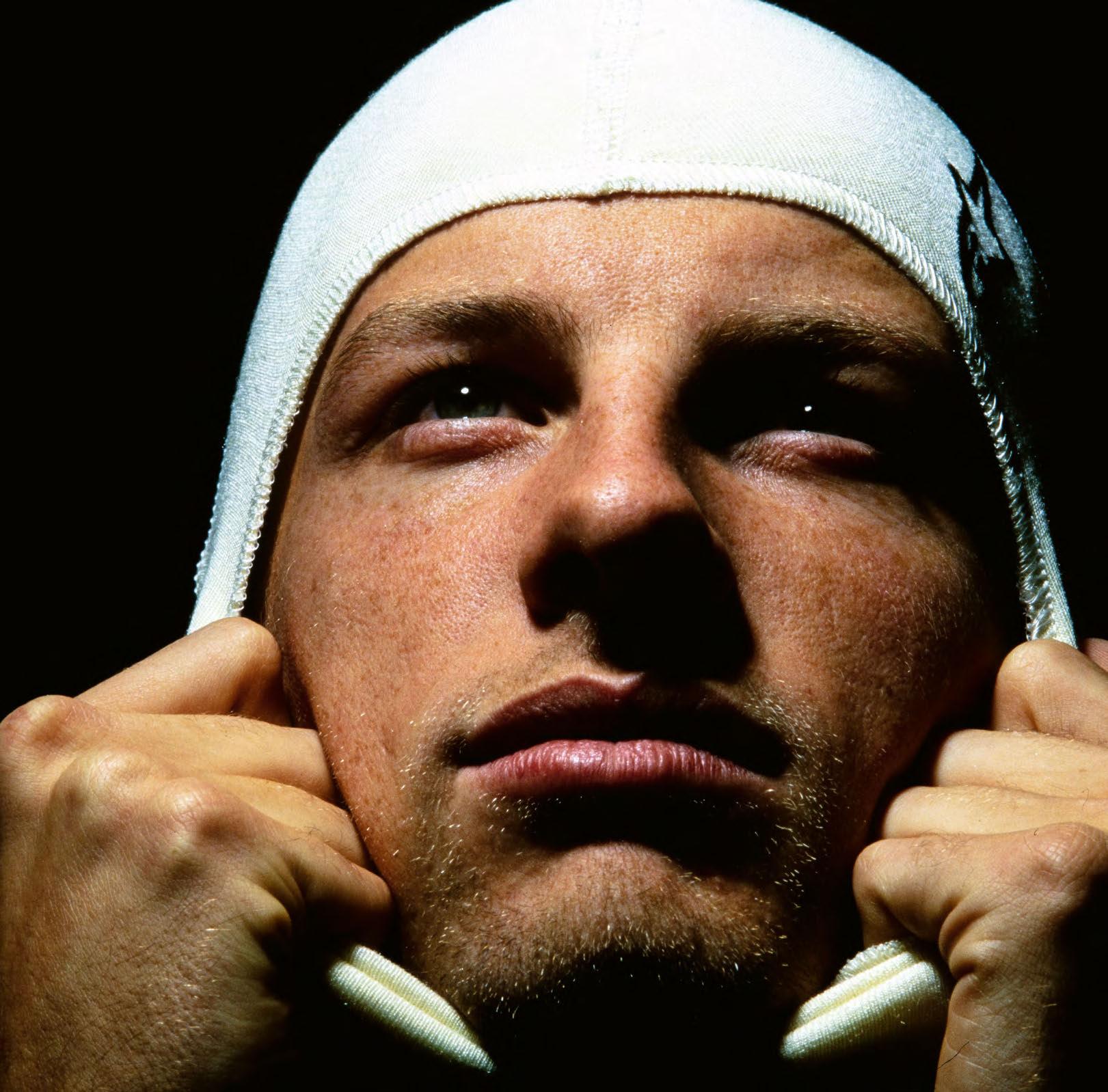

JENSON BUTTON
2009 WORLD CHAMPION
IT WAS DURING THE PENULTIMATE pre-season test of 2009, at the Circuit de Catalunya near Barcelona, that the cat leapt from the bag.
Jenson Button and Rubens Barrichello, refugees from the axed Honda Formula One entry and now paired at a Brawn GP squad scraped from the remnants of the Honda collapse, sat pretty at the top of the timesheets: first and second for a team brought back from the dead.
A handful of the photographers and journalists present on the final day’s running sprinted to their laptops to place bets, with insanely long odds, on Jenson or Rubens becoming 2009 champion, and on Brawn winning the constructors’ title. Those brave enough to commit that March week would be handsomely rewarded come November.
Barely three months later, the F1 season had taken on a mirage-like quality. Button had won six races out of seven, streaking away from the field like a latter-day Jim Clark – all smoothness and precision – to lead the Drivers’ Championship with authority. The performance of the lightly sponsored BGP 001 seemed scarcely believable and, sure enough, the double diffuser aerodynamic solution used at the rear of the car’s underbody was protested by several rivals. The Williams and Toyota teams, who had also developed their chassis around double-diffusers, found themselves similarly subject to protest, but the designs were declared legal and early-season results left to stand.
Button and Brawn took advantage of the situation while their rivals played catch-up, and the points buffer they established proved essential for their eventual success, as a lack of finance began to tell against the might of McLaren, Ferrari and Red Bull, all of which won Grands Prix in the second half of the season. But a battling drive from 14th to fifth at the Brazilian GP was enough to secure Button’s sole drivers’ title with a race to spare. The scenes of rapture that greeted the result were as unconfined as any witnessed in the sport’s history. Particularly touching was the tearful embrace between Button and his father, John, who had supported his son’s racing since the earliest days and who remained a constant, pink-shirted presence throughout Jenson’s F1 career.
Perhaps they had begun to fear the title would never come, for just as Button’s World Championship triumph had been the unlikeliest imaginable, so had his F1 career as a whole failed to follow the script. He burst onto the F1 scene in 2000, fresh from a strong season in Formula Three, blessed with a calling-card smoothness and delicacy of touch in mixed-weather conditions that marked him out as a driver with an unusually cultured skillset. Tests for both the Prost and Williams teams duly followed.
Benetton, Button had at least developed some of the resilience he would call on later in his career, as his obvious talents serially failed to find a happy match with a competitive team.
Joining BAR-Honda in 2004 promised a breakthrough, as Button clocked up 10 podium finishes and posted his first pole position to finish a respectable third in the drivers’ table. It was his (and others’) misfortune that year to come up against a superlative Ferrari, which won 15 out of 18 races – 13 of them scored by Michael Schumacher in his pomp.
The following season was tarnished by a fuel tank illegality scandal, but finally, after 113 attempts, Button won his first Grand Prix in famous style at Hungary’s Hungaroring circuit in 2006. To say the win had been a long time coming does no justice to the sense of expectation that had surrounded Button since his debut. Routinely heralded as the ‘next big thing’, at least in the partisan British press, his career up to that point had failed to live up to the hype (never more so than during an interminable contractual tussle between Williams and BAR throughout 2005). On this day in Hungary, however, he was imperious, winning by more than 30 seconds from 14th place in mixed conditions to which his soft skills were perfectly attuned. The win was also Honda’s first in F1 as a factory team since 1967.
A strong finish to 2006 seemed to have set Button up well for 2007, but the two seasons that followed came close to terminating his career. He scored only nine points across 2007–08 and – far worse – the global financial crash of 2008 allowed Honda a blameless exit from an apparently doomed F1 project. It was from these ashes that team principal Ross Brawn dragged the essence of a race team and agreed a deal to buy the rump operation from Honda for a nominal fee. Crucial to the team’s viability was an engine deal agreed with Mercedes, which supplied a top-line motor to what would prove a front-running chassis. Cue Valhalla.
Even a season as charmed as 2009 ended with a sour note, however. Contractual discord between Button and the team resulted in his exit for McLaren, as Brawn were snapped up by Mercedes to metamorphose into 21st-century Silver Arrows. The move was complicated by the presence at McLaren of Lewis Hamilton, unquestionably the most precocious talent to have alighted in Formula One for a generation.
CAREER STATS World
As a fluff-chinned 20-year-old, he stopped the show by qualifying third for the 2000 Belgian GP, while unwittingly establishing himself as something of a media darling. His charms failed, however, to win over his next boss, Flavio Briatore, who infamously withered that Button ‘would never be a World Champion’. After two trying years at
Some pundits predicted a drubbing, but over 2010–12, Button edged his vaunted teammate by 672 points to 657. Those stats reveal nothing of their true relative performance and even the most ardent Button fans wouldn’t claim he had Hamiltonmatching pace. He had, though, flourished in a true top team and found some kind of professional serenity late in his career. And it was with McLaren that Button remained, through to his final full season, 2016, despite the team’s fall from frontrunning pace. While never the outright fastest, Button can claim to have possessed as refined a touch as any F1 great and to have co-authored maybe the most unforgettable title run of all.
YAS MARINA ABU DHABI
RISING LIKE A DESERT MIRAGE ON THE edge of the Persian Gulf, Yas Marina Circuit is the very expression of a 21st-century Formula One facility. Pristine and with immaculate, spacious working environments for teams, officials and media, it is beyond rational criticism. Soulless? Of course – but how could it not be, given its apparition from once-empty sands. A classic track? Not in the least, by comparison with the glories of Monza, Spa and Monaco.
Yet in the years since its glitzy arrival on the Formula One calendar in 2009, the Abu Dhabi Grand Prix has developed a charisma of its own, thanks in part to the championship-deciding season finales it has hosted. A teary Sebastian Vettel became F1’s youngest champion there in 2010. In 2016, Nico Rosberg was squeezed in a Hamilton–Verstappen vice before emerging as that year’s champion. Then in 2021, Yas hosted among the most dramatic finales the World Championship has ever witnessed: Lewis Hamilton versus Max Verstappen in a title shoot-out that wasn’t decided until mid-way through the final lap (see Chapter 5: Rivalries). Formula One purists find Yas hard to love, but its measurable excellence has made it hard to ignore.
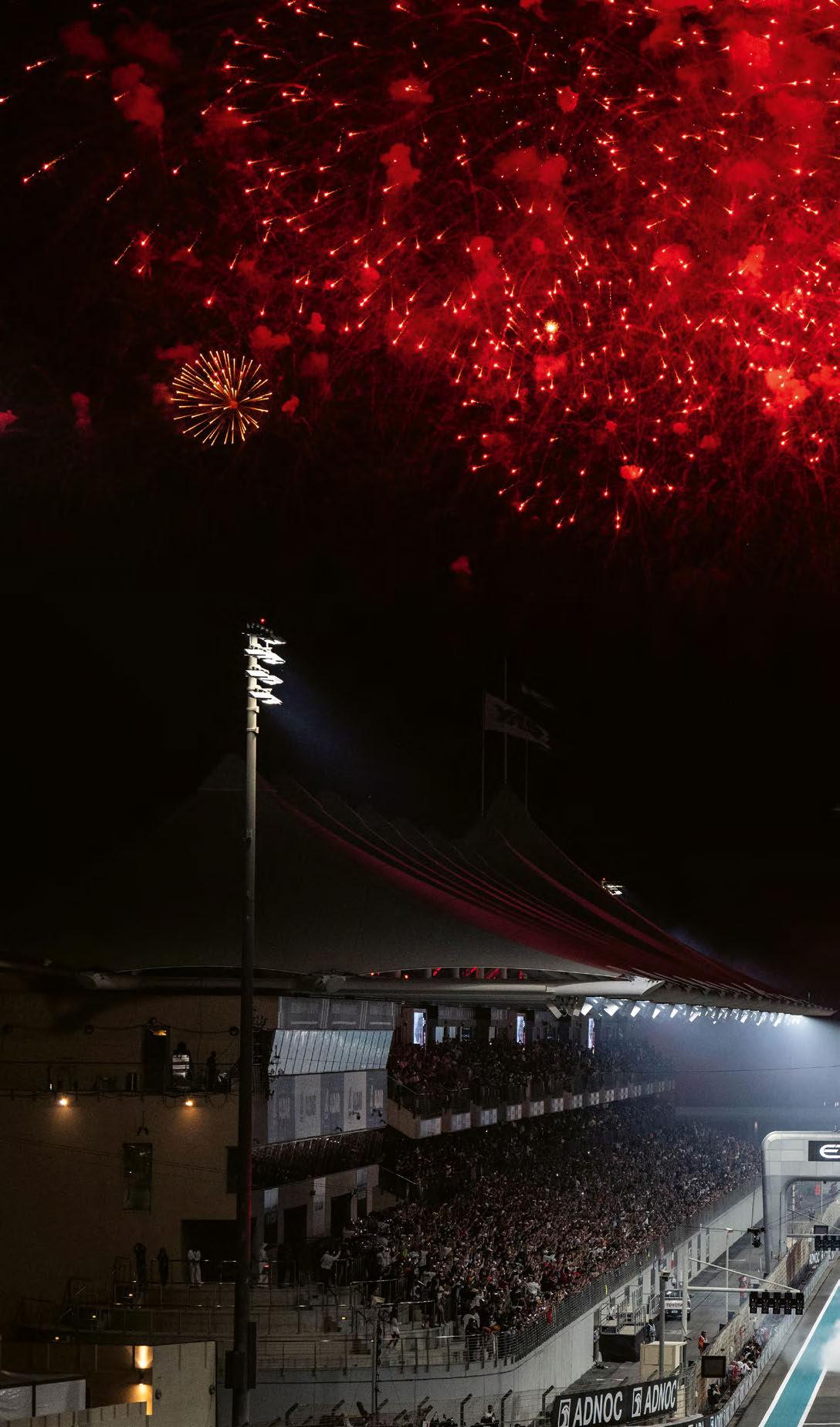

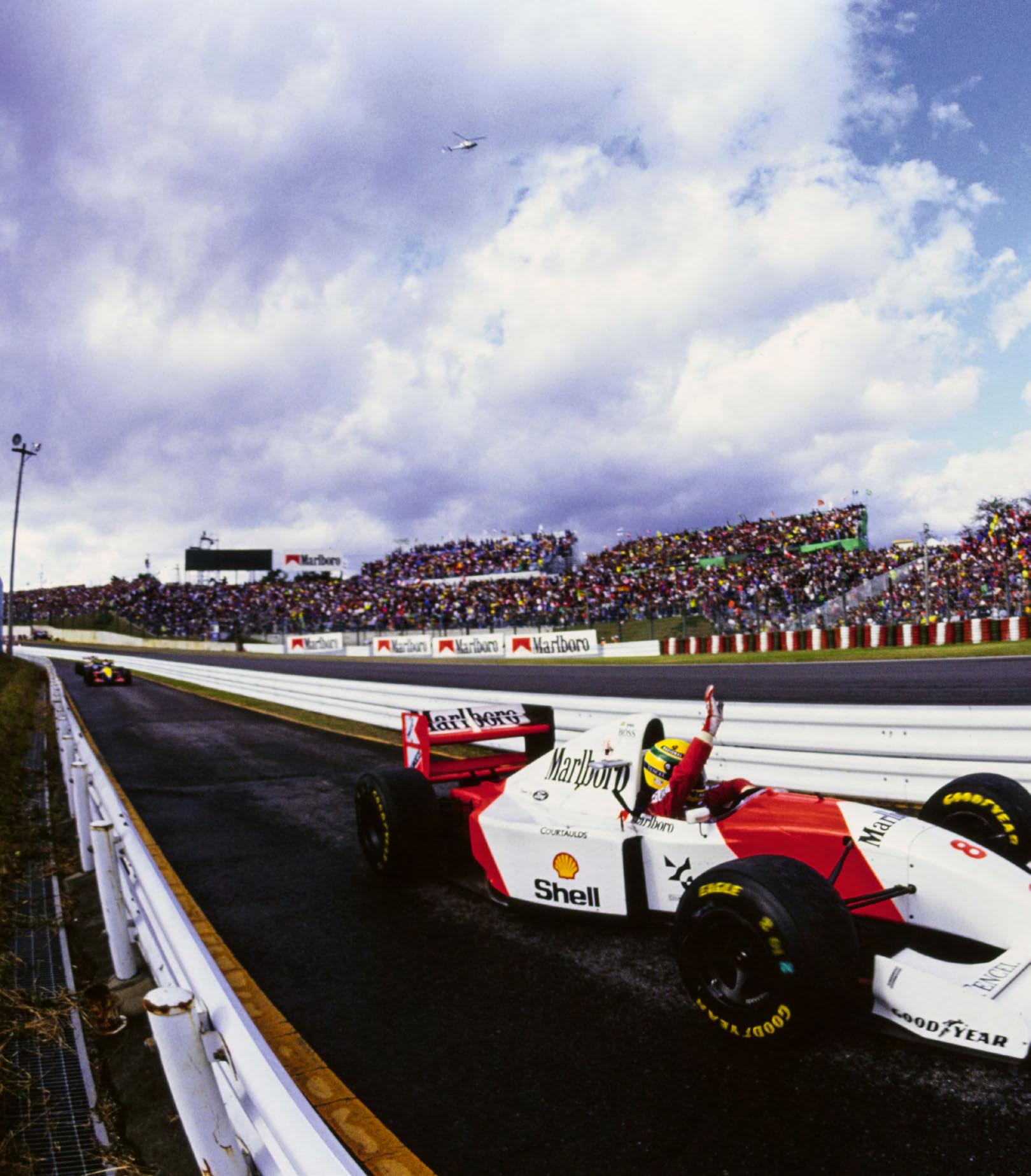
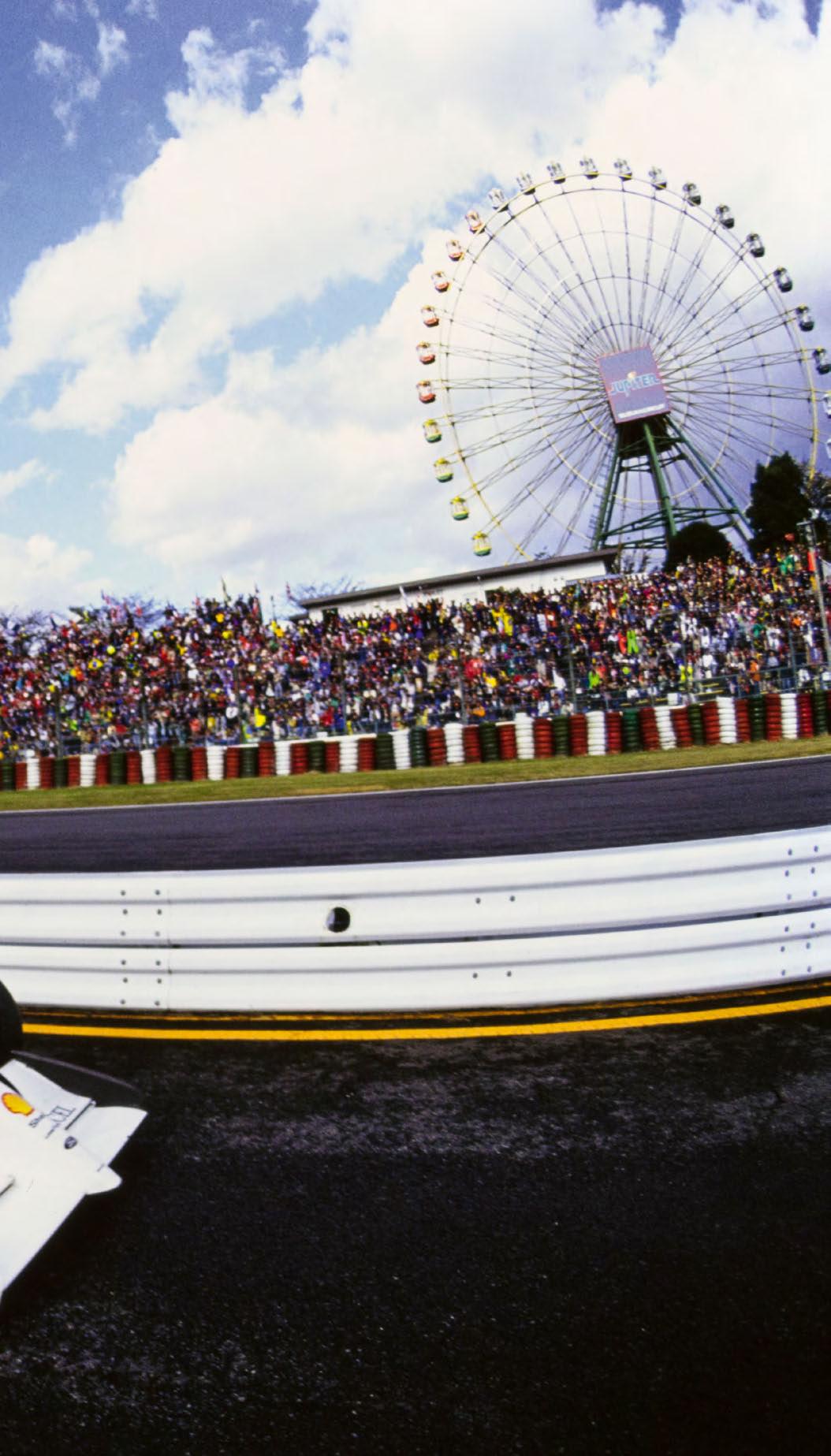
SUZUKA JAPAN
NO CIRCUIT IN FORMULA ONE HAS EVER received quite the veneration accorded to Suzuka. Others might be feared, respected or perhaps celebrated for their proximity to a lively city. Suzuka is simply adored by drivers.
They can thank Dutch circuit designer John Hugenholtz for their pleasure. He was commissioned by Honda in the late 1950s to design a track that could be used for road car development as well as racing. His entrancing, fluid, figure-of-eight ribbon was the result. Almost 30 years passed before Suzuka was included on the F1 calendar in 1987, the two previous Japanese Grands Prix having been held at the Fuji circuit. Since then, it has been present almost without interruption, hosting some of the sport’s most memorable moments.
There was drama from year one, as Nigel Mansell crashed out of his 1987 title bid having overcooked it through the demanding Esses section. In 1989 and ’90, Alain Prost and Ayrton Senna came to blows, settling the championship via car-to-car contact. More recently, the 2005 edition of the race was hailed in many quarters as one of the greatest ever Grands Prix, during which Kimi Räikkönen and Fernando Alonso flew through the field to win and finish third.
There is unquestionably also a dark side to Suzuka, one sometimes disguised by the joyous enthusiasm of the fans who throng to every Grand Prix. Its intoxicating thrills have lured many drivers into serious accidents, none more so than the eventually fatal impact suffered by Jules Bianchi during the 2014 GP. Suzuka races have also frequently been assailed with extreme weather conditions, adding meteorological hazard to an already challenging topography. Nonetheless, its popularity among the Grand Prix fraternity is assured. If Formula One was not already blessed with a Suzuka, it would have to invent one.
GILLES VILLENEUVE vs DIDIER PIRONI
THE SEASON OF 1982 WAS ONE OF GREAT promise for Ferrari. Their 126C2 had a turbocharged engine at least the equal of its rivals, while a major chassis upgrade from the previous year gave grip levels to match leading competitors. As for drivers, in Gilles Villeneuve and Didier Pironi they had two incendiary talents – Villeneuve more flamboyant and instinctive, Pironi more calculated, but both brilliant and potential champions.
At round four, the San Marino GP, they ran one–two as the race progressed, Villeneuve ahead, no one near them. They swapped and re-swapped positions in the closing stages, leaving Villeneuve leading into the final lap. Approaching the Tosa hairpin for the last time, Pironi passed Villeneuve – contrary to team orders in Villeneuve’s view –and charged to the chequered flag. Villeneuve believed he had been duped and later told Autosport magazine, ‘I trust anyone until they break that trust and I will not speak to Pironi again – ever. From now on it’s war. Absolute war’. Two weeks later, Villeneuve crashed fatally at the Belgian GP, he and Pironi still unreconciled.
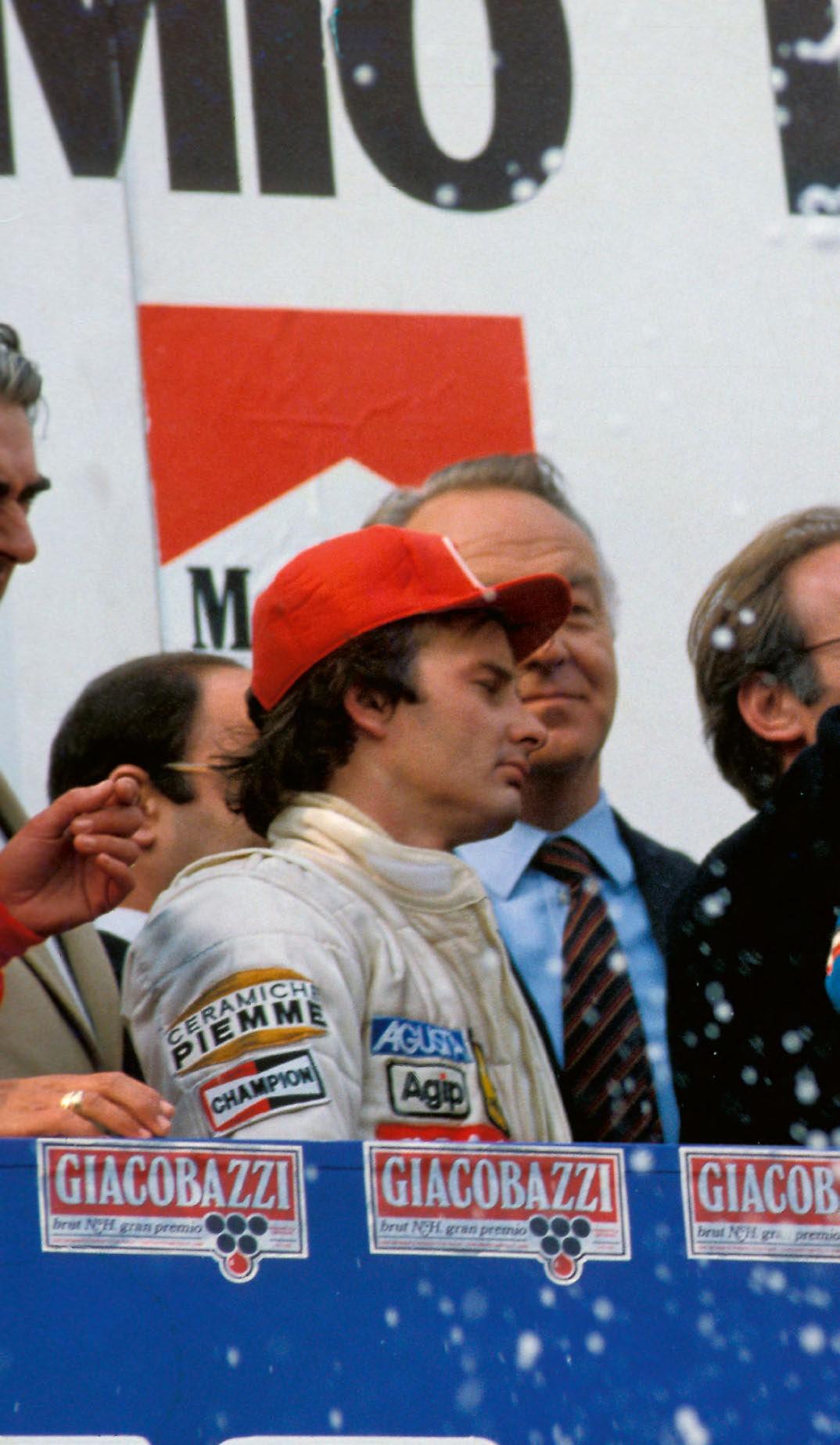
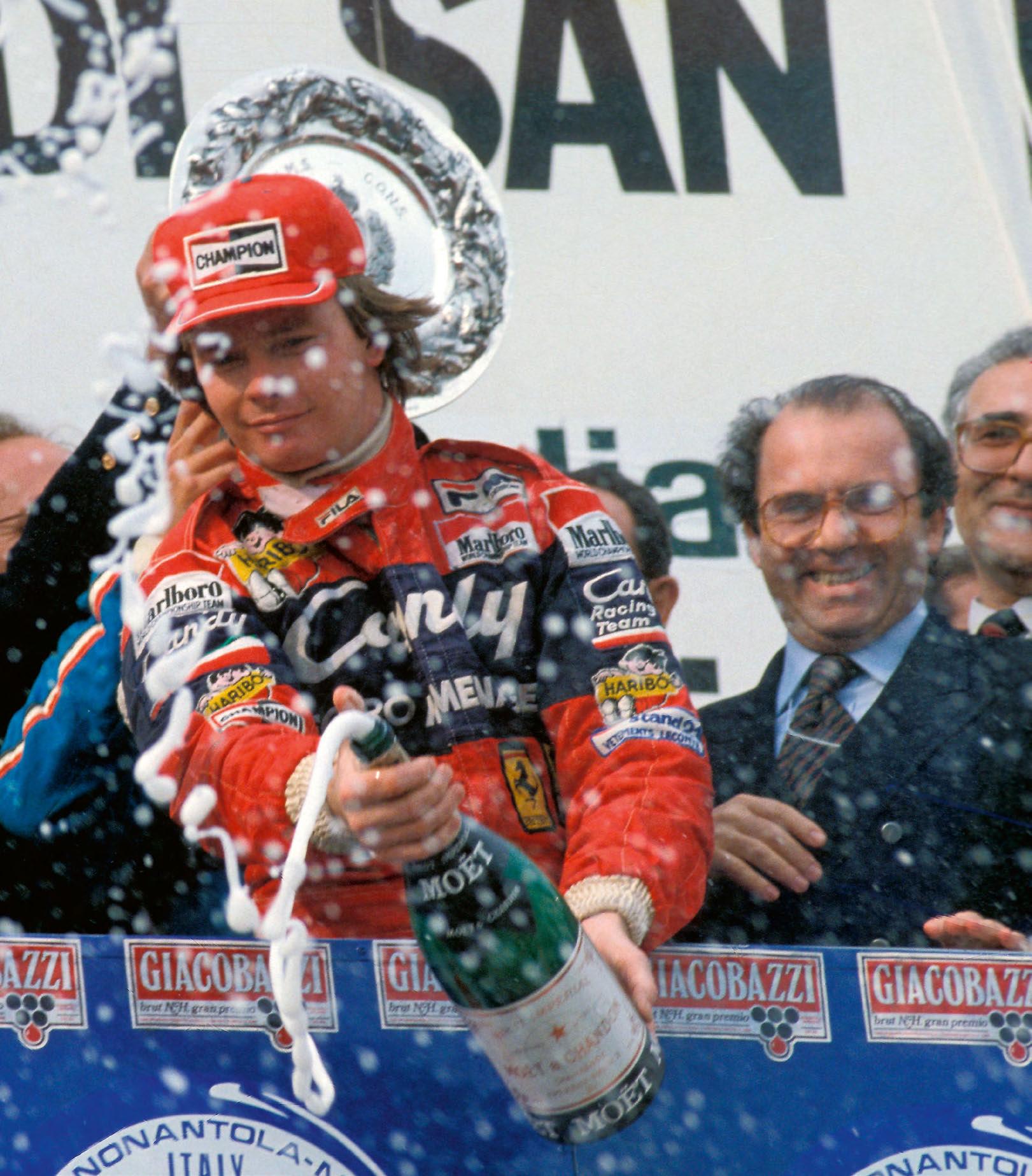

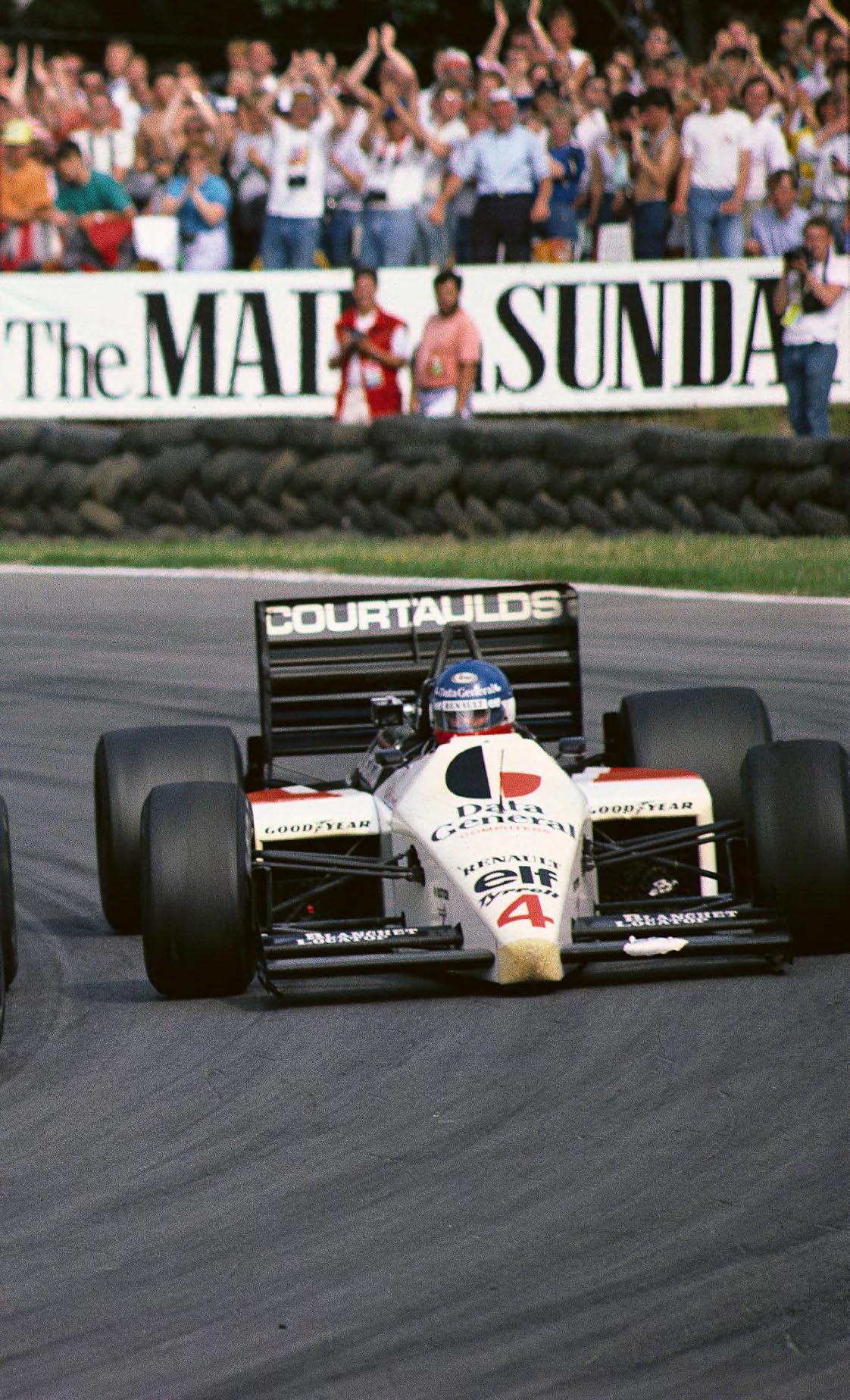
NIGEL MANSELL vs NELSON PIQUET
SUCCESS HAD COME QUICKLY TO NELSON Piquet in Formula One. He was a race winner in only his second full season and a World Champion in his third. A second title came two years later in 1983, and to many eyes he was the sport’s best driver at that time; certainly its most glamorous. He would not have expected, three years later, to be beaten up – almost literally, such was the venom of their intra-team rivalry – by a flat-capped Brit called Nigel Mansell, who just happened to be every bit as fast as Piquet. Mansell had served a far tougher apprenticeship to earn a ride in the rocketship that was the 1986 Williams FW11. No way was he going to let Piquet’s reputation halt his progress.
By the end of the season, Mansell went into the finale, the Australian GP, leading Piquet and their only title rival, Alain Prost, with a plush points cushion. Tyre trouble blew his title hopes into strips of flailing black rubber, however, allowing Prost through to a second consecutive World Championship. A year later, Williams’ advantage with the FW11B was once again huge and this time Piquet used all his guile (even goading Mansell’s wife) to get under his teammate’s skin and find a way to win his third world title. Mansell crashed out of contention during practice for the Japanese GP, pushing too hard to claw back Piquet’s advantage. He had won six races to Piquet’s three, but it wasn’t enough.
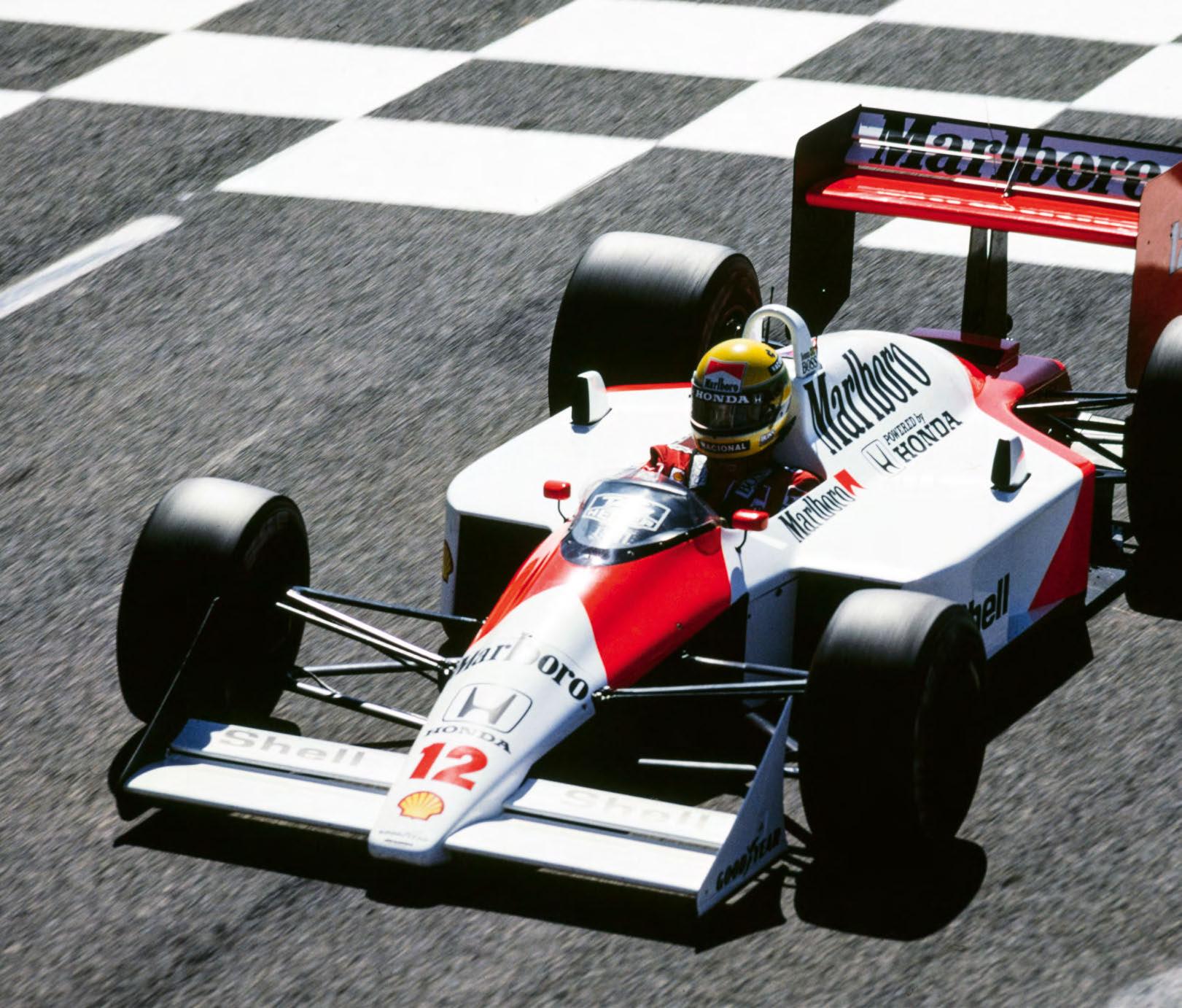
Ayrton Senna, Circuit Paul Ricard, 1988
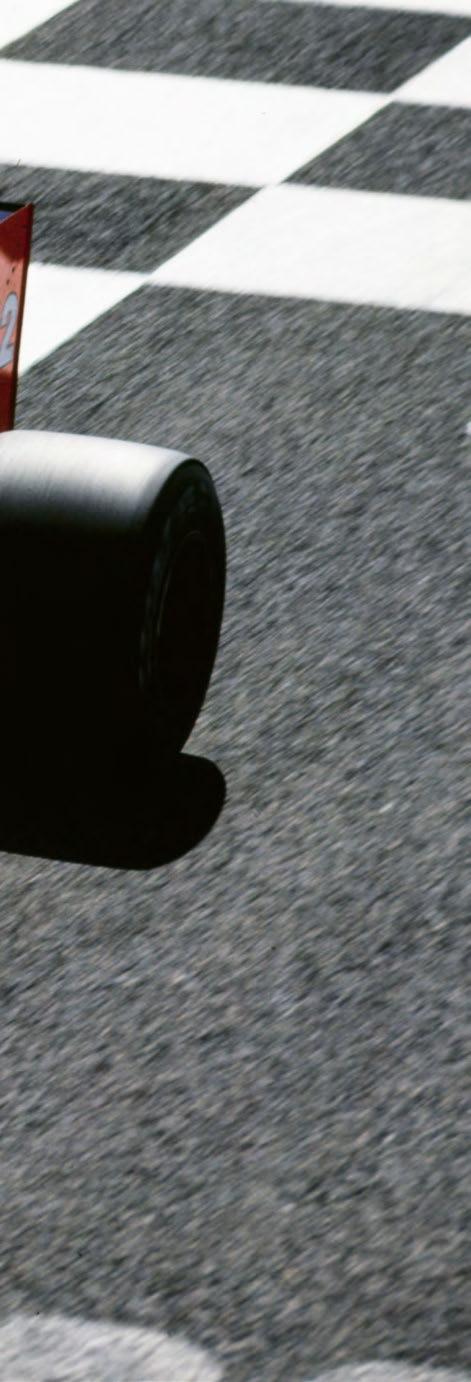
THE GREATNESS OF THE MCLAREN MP4-4 results not only from the elegant simplicity of its design and engineering, it was also the car that allowed the two best drivers of their age – Ayrton Senna and Alain Prost – to stage a mesmerising fight for the 1988 drivers’ title on a plane completely separate from their rivals.
As teammates, they won 15 of the year’s 16 Grands Prix, with 15 pole positions and ten 1–2 finishes, having led 1,003 laps of the 1,031 total. Only a fumble at the Italian GP, where Senna tripped over the hapless Jean-Louis Schlesser at the Rettifilo chicane, two laps from the chequered flag, sullied what would otherwise have been a clean sheet for McLaren – an astonishing achievement in an era when mechanical unreliability would regularly end a driver’s race.
McLaren’s stranglehold of the 1988 season was their peak during a decade they largely co-owned with Williams. McLaren had controlled the mid’80s with the Porsche-powered MP4-2 series of cars before Williams hit back with their Hondadriven FW11s of 1986–87. The power and efficiency of the 1.5-litre Honda V6 turbo motor was a league apart from any rival offering (thanks in no small part to an estimated $50m annual budget) and McLaren boss Ron Dennis knew he simply had to have it. He snatched the prized engines from Williams during ’87, then plundered Lotus for Senna – still yet to win a championship despite the brilliance he had shown since his F1 debut in 1984.
But what of the chassis? Dennis had lost his technical superstar, John Barnard, to Ferrari in 1986, and with him went a design lineage that stretched back to the early ’80s. A reset was needed for ’88 if McLaren were to capitalise on their advantage in all other departments. Dennis, in his pomp as a team principal, achieved another masterstroke by luring the free-spirited, freethinking design maverick Gordon Murray from Brabham. As technical director of a team that included chief designer Steve Nichols, Murray contributed to a design that would prove devastatingly effective.
The hallmark of the MP4-4 was its low-line profile, a design concept sometimes attributed to
1980s: McLaren MP4-4 (1988)
Murray’s pioneering ‘skateboard’ Brabham BT55 design of 1986. Others maintain the MP4-4 was evolutionary and that the car’s stance resulted from a new Honda engine designed to be as compact as possible, plus fuel tank limits mandating a capacity of only 150 litres for turboengine cars. Clever transmission engineering allowed maximum benefit to be gained from the low-lying engine, but little else was radical. Clarity of concept and excellence of execution were the MP4-4’s winning strengths.
In Art of the Formula One Race Car (2010), Murray explains: ‘It was such a simple car, but we found a massive improvement in aerodynamics. And it handled very well. I’ve always liked very simple things. I wanted to bring the driver back down to Chapman levels. Over the years they’d been creeping back up again, the designers were looking to package more and more fuel behind the driver and the engines were getting bigger. There was no point in having the driver low – until we got to the turbo era.’
The results speak for themselves: the MP4-4’s win rate was 93.75 per cent – a mark which stood until 2023, when Red Bull’s RB19 pipped it with 21 wins from 22 races (95.45 per cent). And while its scorecard benefitted from the relative disarray of rival teams in ’88, there is little argument that Senna, Prost, McLaren and Honda made the most of what they had. The MP4-4 remains a high-water mark for F1’s turbo era: turbo-charged engines were banned at the end of the season.
RACE RECORD
Championships: 2 (1x Drivers’; 1x Constructors’)
Race wins: 15
Pole positions: 15
Fastest laps: 10
Fangio’s greatest day?
This rare colour shot captures The Maestro winning the 1957 German GP at the Nürburgring, having passed the Ferraris of Mike Hawthorn and Peter Collins on the penultimate lap, after an epic comeback drive.
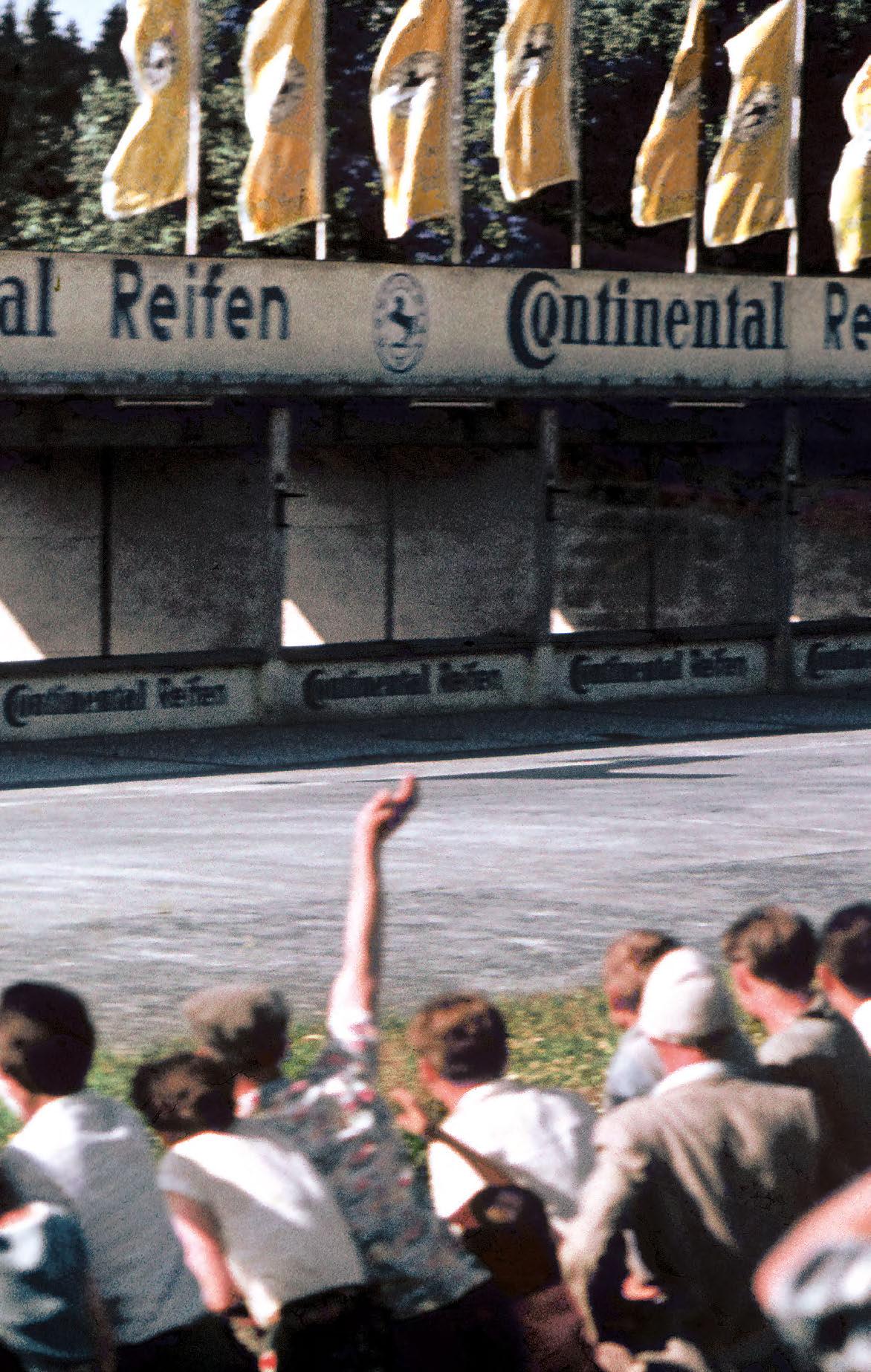

Gang of four. Ayrton Senna (Lotus), Alain Prost (McLaren), Nigel Mansell (Williams) and Nelson Piquet (Williams) were all in contention for the 1986 drivers’ title when this shot was taken at the Portuguese GP, with three rounds to go. Prost won the championship, his second of four drivers’ titles; Piquet won his third in ’87; Senna was champion in ’88, ’90 and ’91; Mansell won the title in ’92.

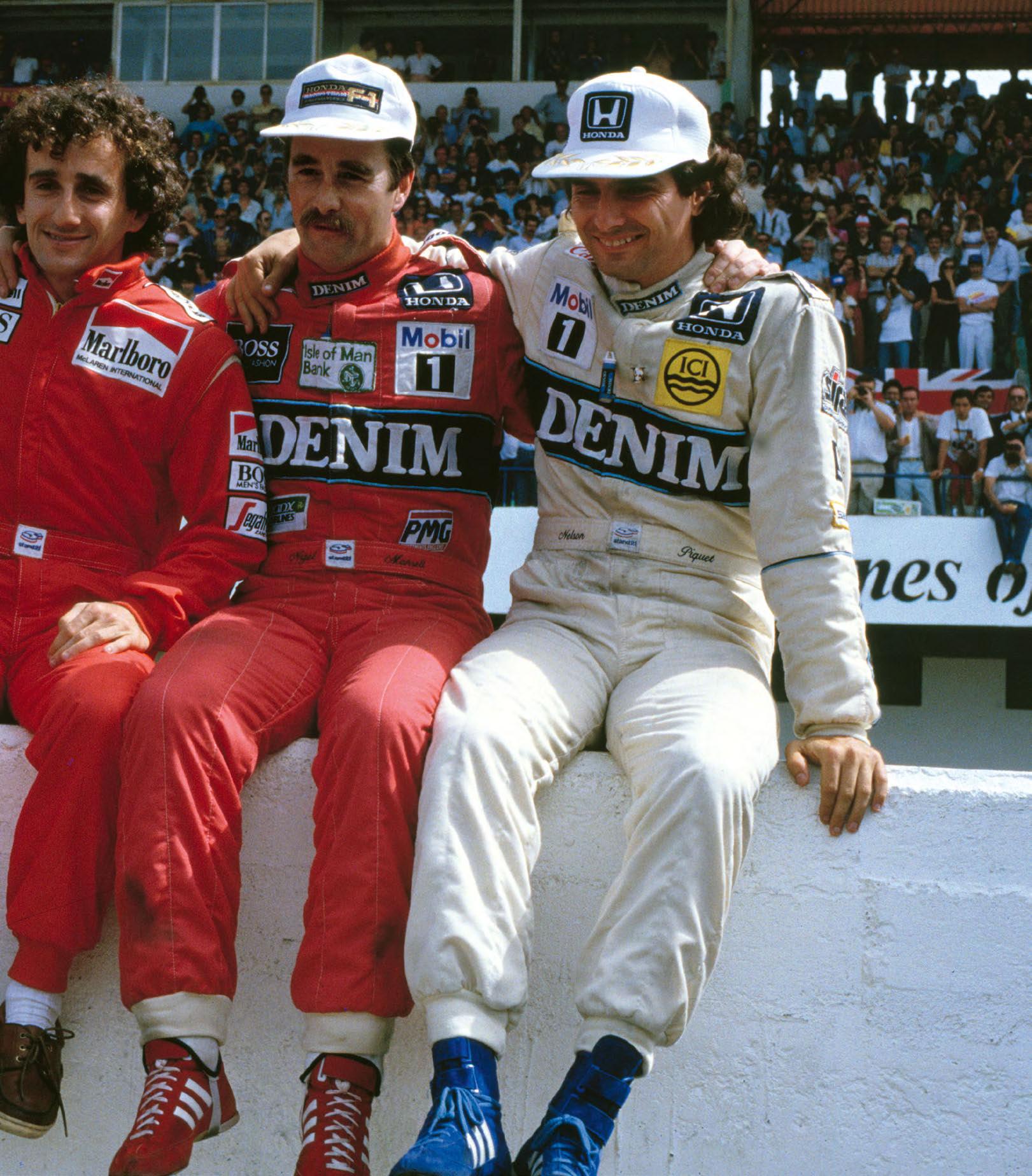
Benetton mechanic
Paul Seaby is engulfed in flames as spilled fuel ignites into a fireball during a pitstop for Jos Verstappen at the 1994 German Grand Prix.
Verstappen and his mechanics all escaped without permanent injury.
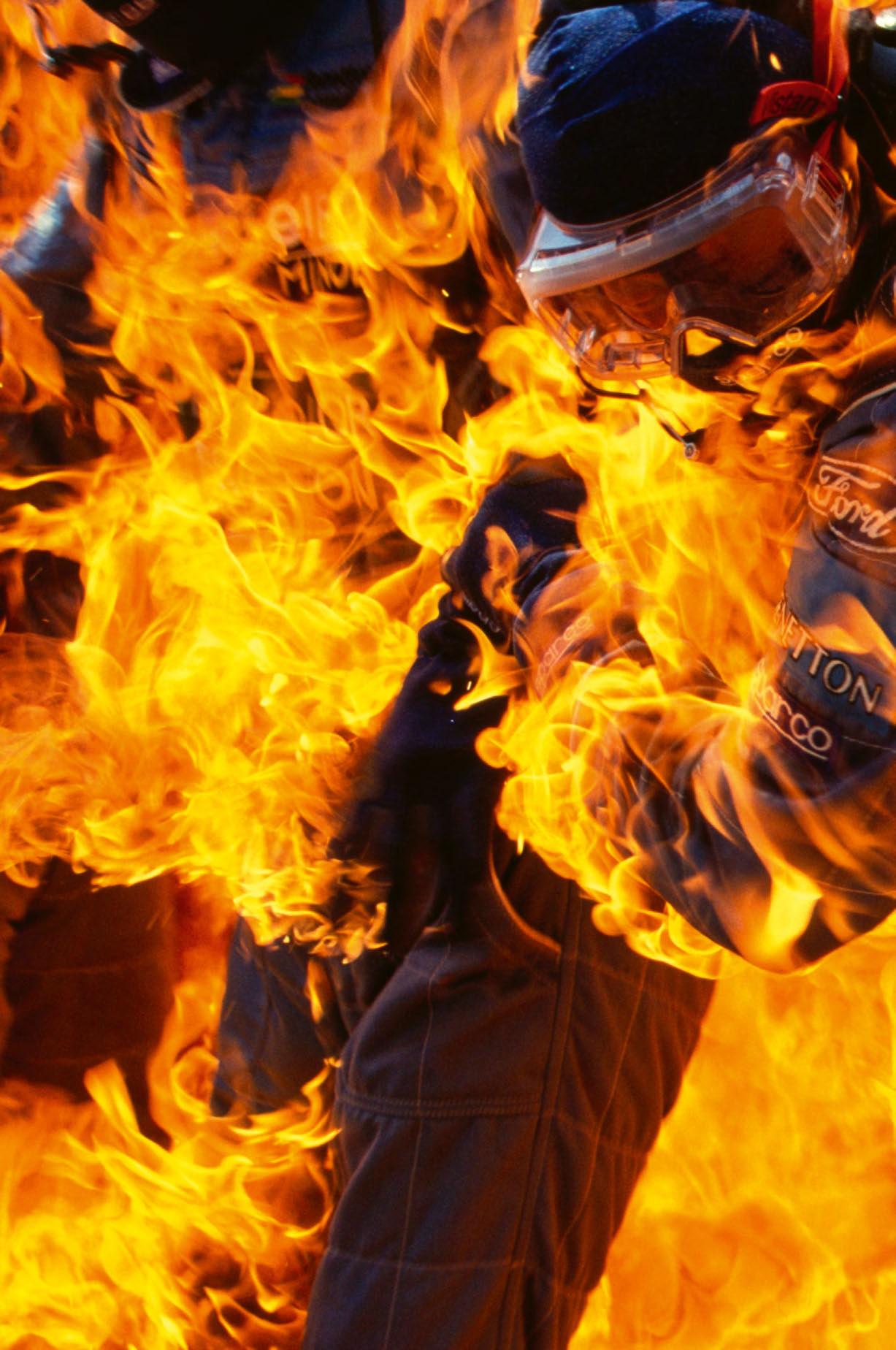
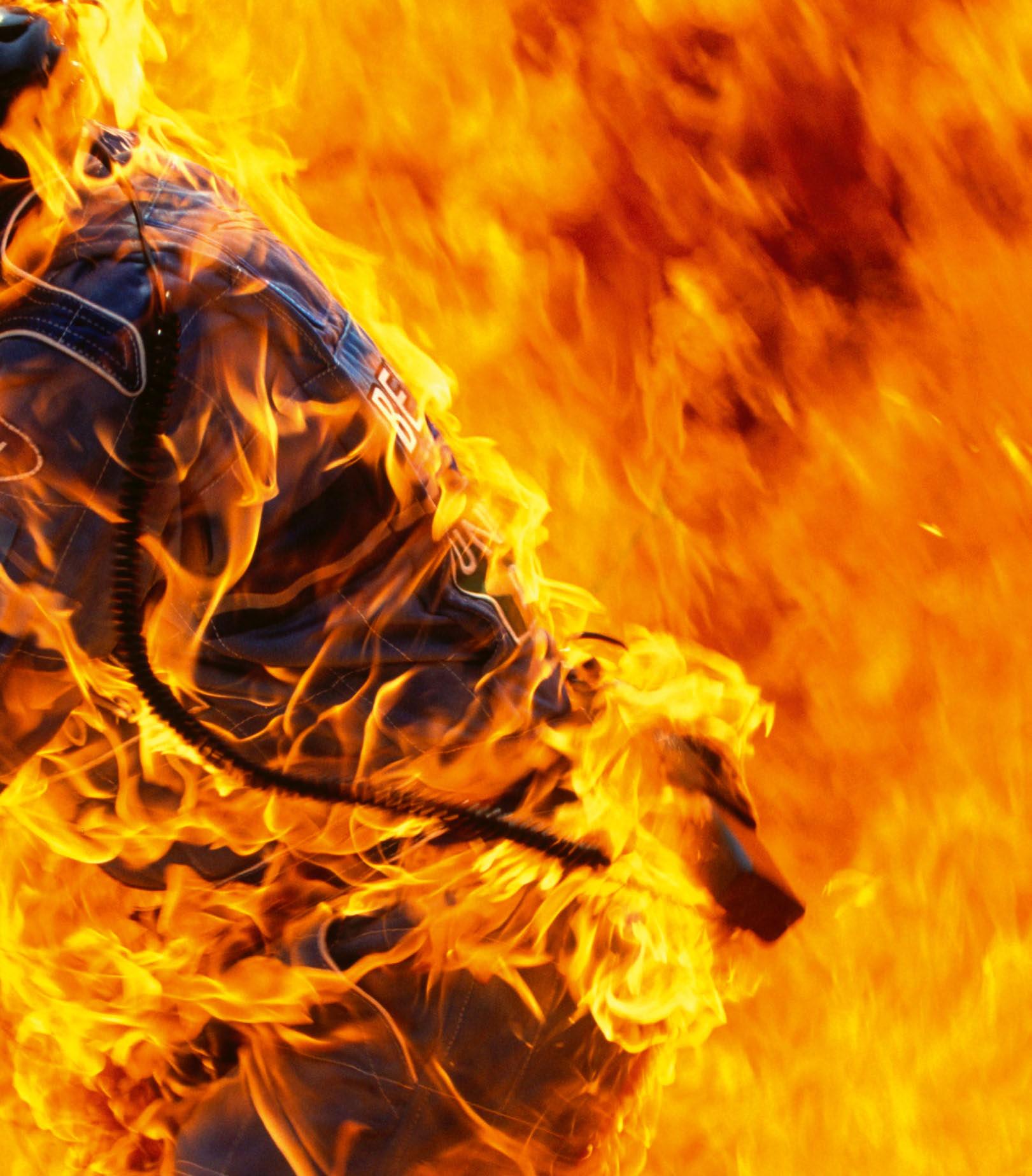
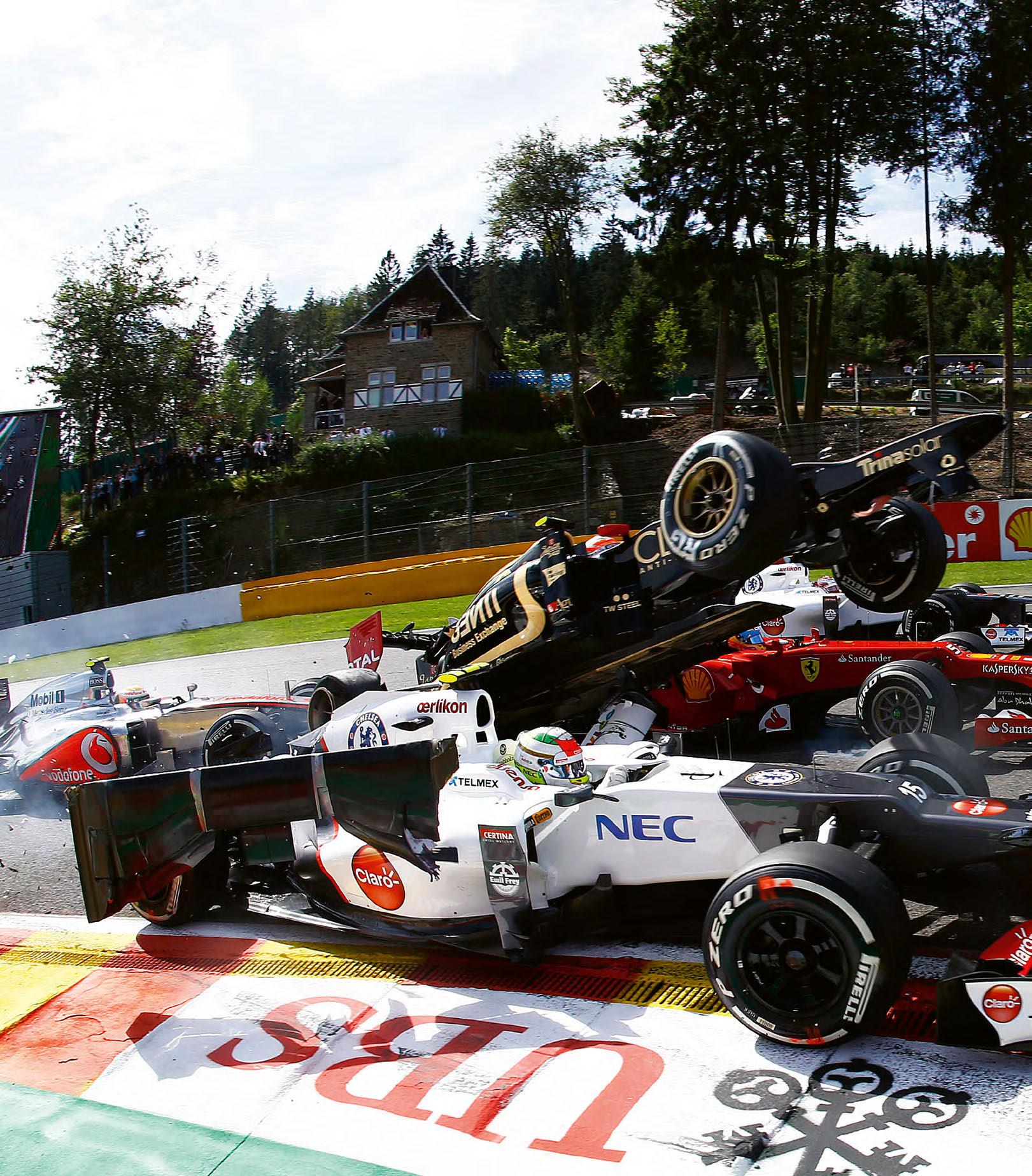
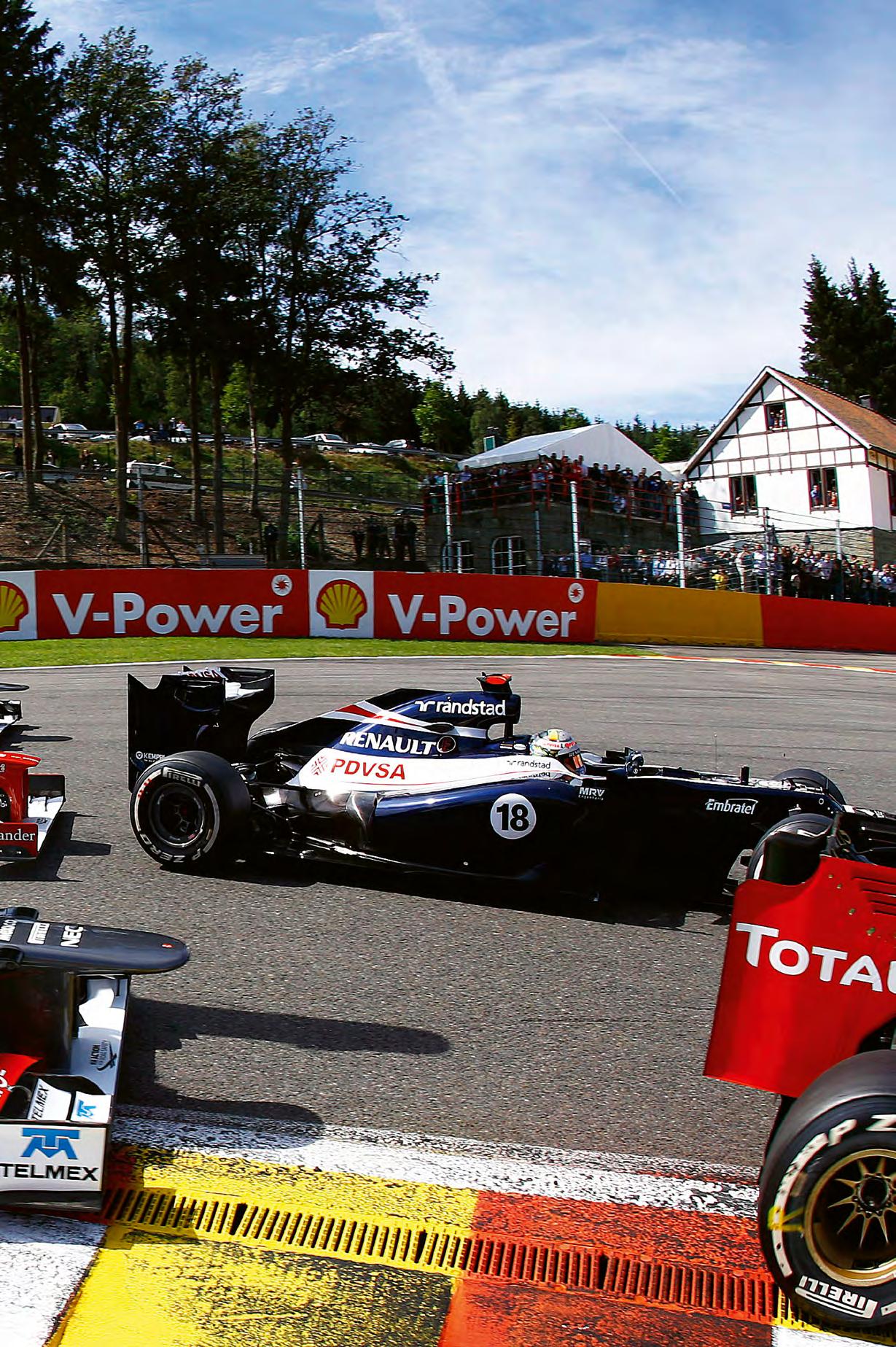
This crash at the first corner of the 2012 Belgian GP earned Lotus’ Romain Grosjean (mid-air) a one-race ban. When he torpedoed Red Bull’s Mark Webber on lap one of the Japanese GP later the same year, he became stuck with Webber’s dismissive ‘first-lap nutcase’ tag.
The miracle escape for Romain Grosjean at the 2020 Bahrain GP. His Haas speared into the barriers at Turn 3 after first-lap contact with another car and split in two, rupturing the fuel cell. Grosjean’s hands were burned but he suffered no other serious injuries. An accident like this would undoubtedly have been fatal in an earlier Formula One era.
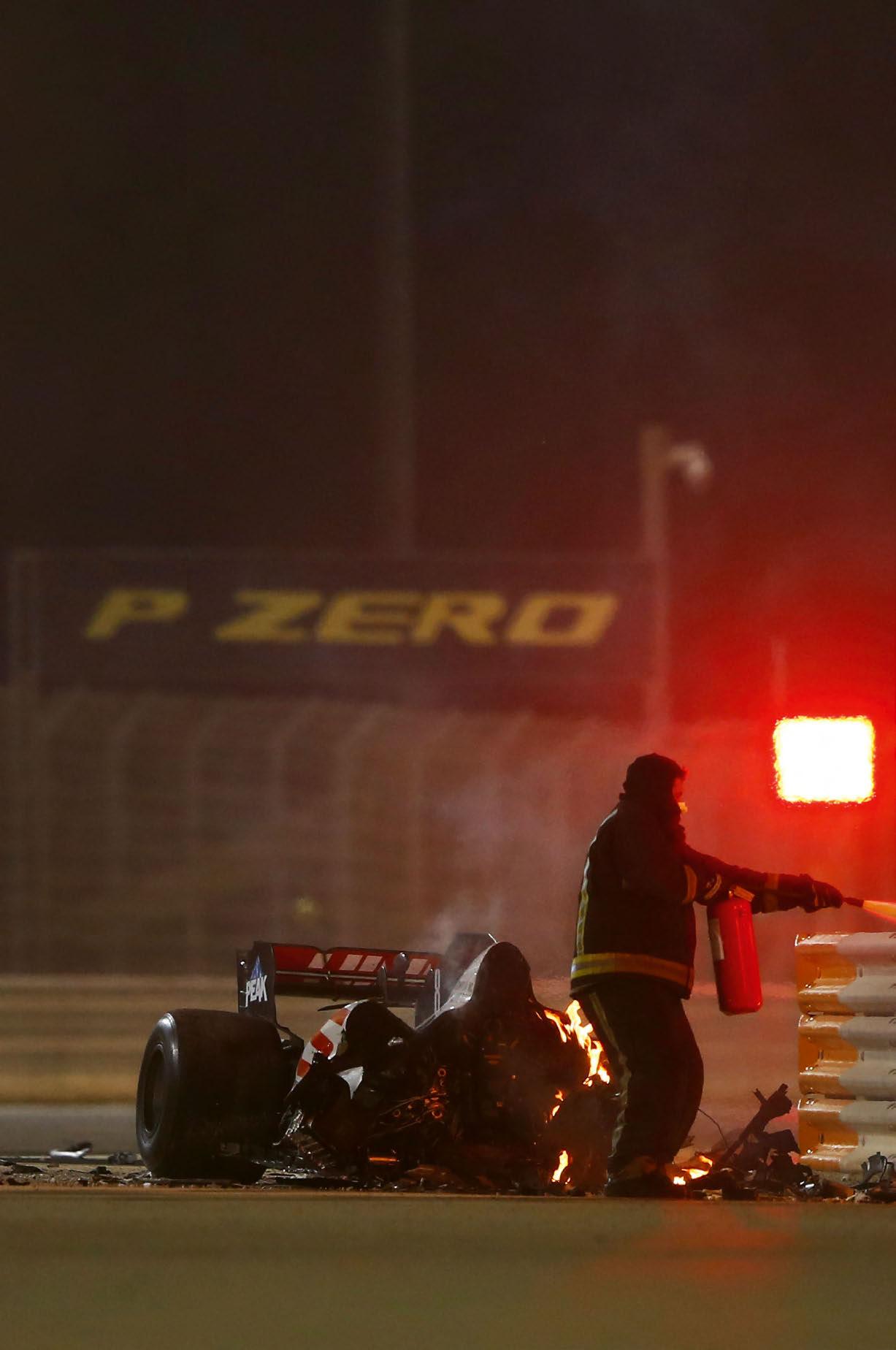


With an introduction by three-times World Champion Sir Jackie Stewart, Grands Prix: 75 Years of Formula One Racing showcases a stunning collection of photographs from the beginning of this thrilling and dangerous sport in 1950, right up to the present day. From the words of the creators themselves, we learn how talented F1 photographers succeeded in capturing the excitement and the speed that is the essence of Formula One. World-class images of the cars, the drivers and worldrenowned circuits such as Monaco, Monza and Silverstone, as well as F1’s most dramatic moments of high-speed combat between the sport’s definitive rivalries, create a comprehensive picture of the world’s favourite motor sport, the Grand Prix.
A closer look at each F1 Champion, beginning with Giuseppe Farina who won the very first Grand Prix, through to the reigning World Champion Max Verstappen, alongside the heroes and icons that make up this spectacular sport, not only reveals the guts, bravado and sheer skill of those who bring motor racing to life, but gives us an insight into how the world of Formula One plays out behind the scenes.
